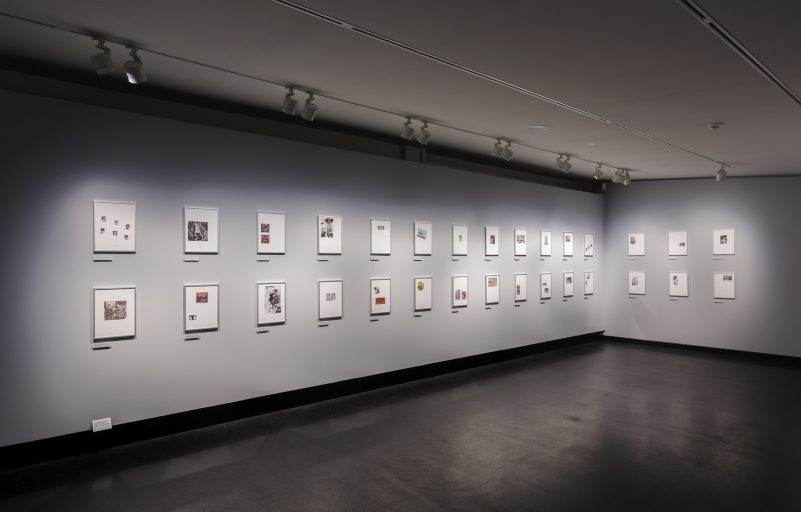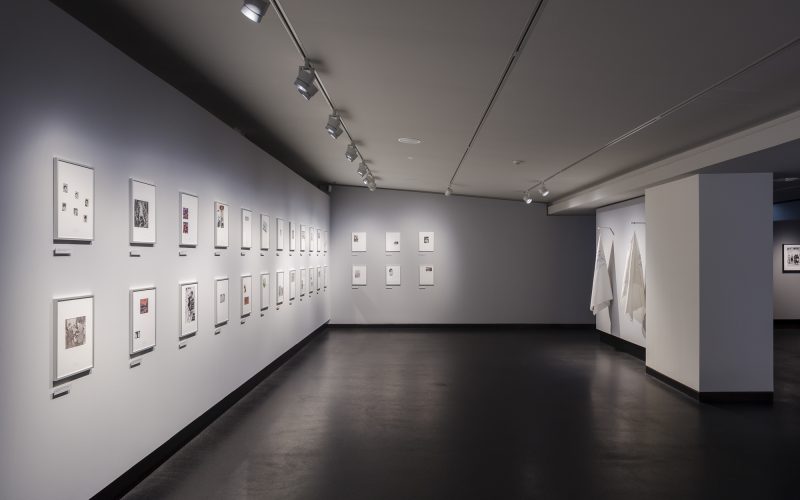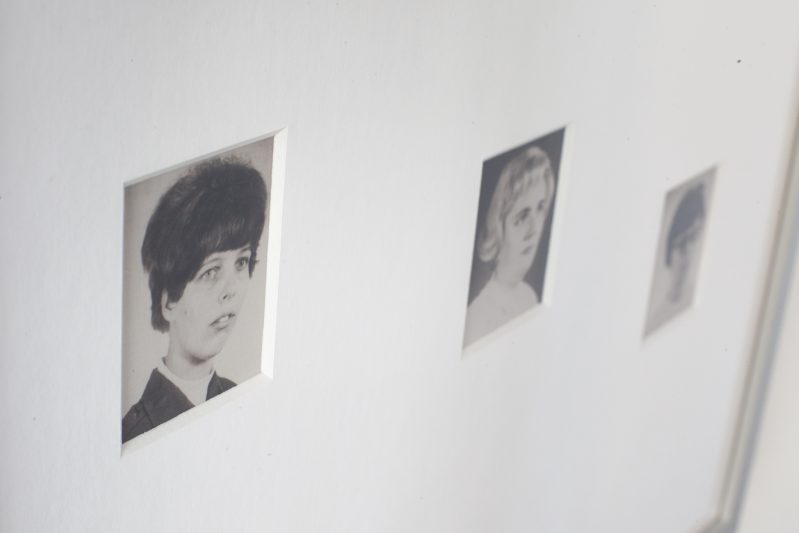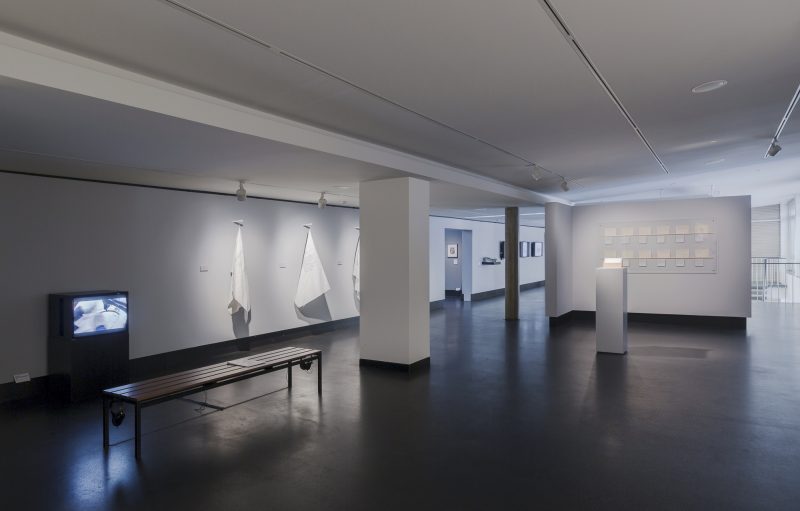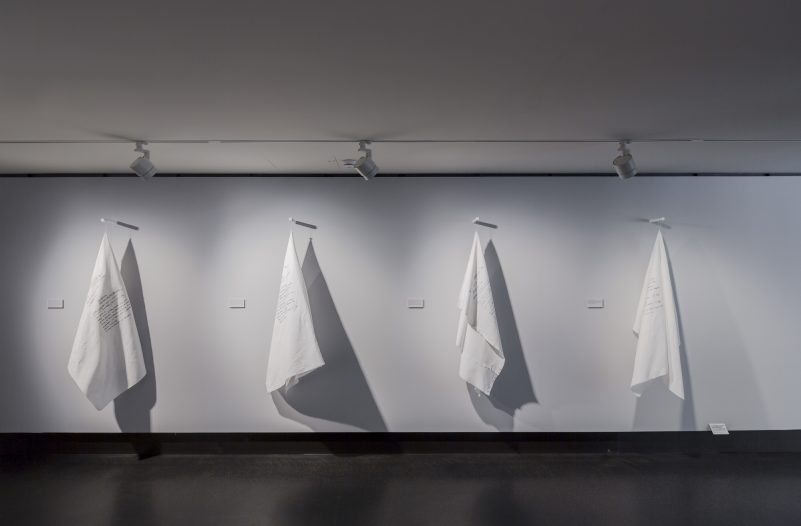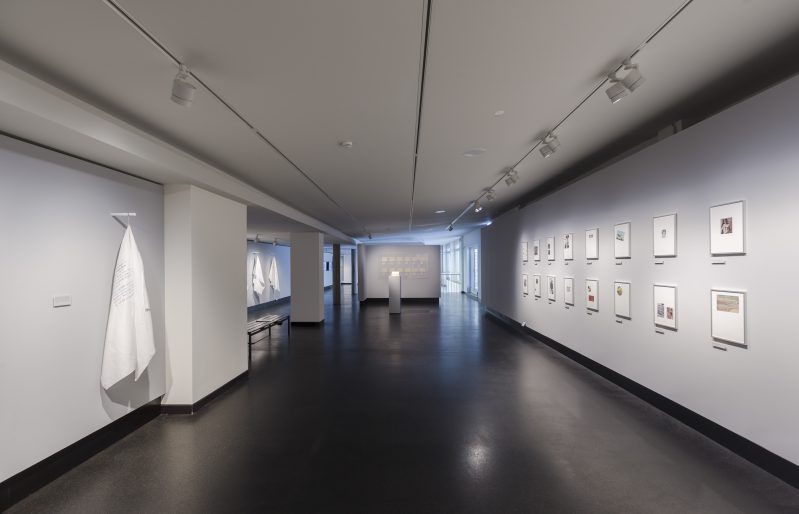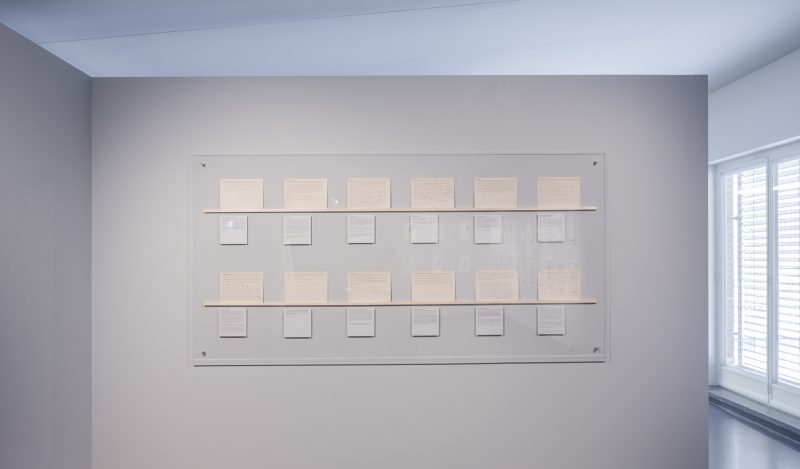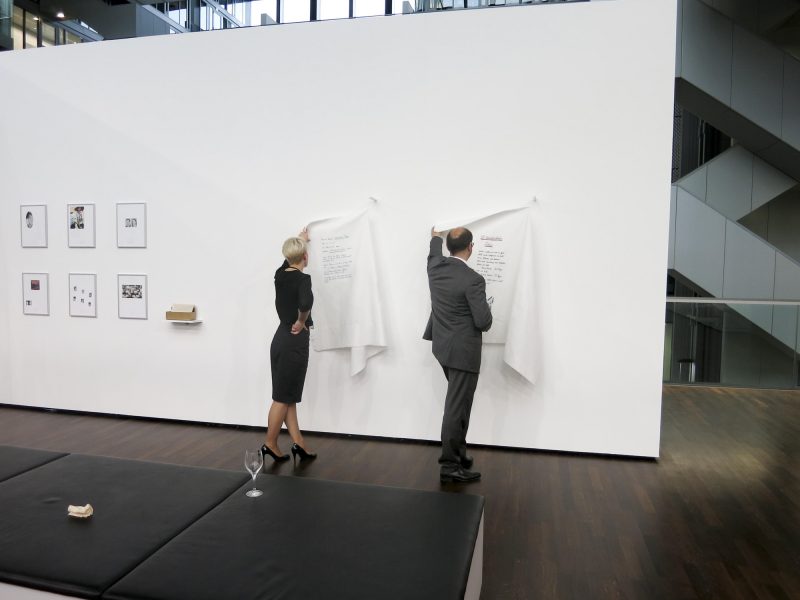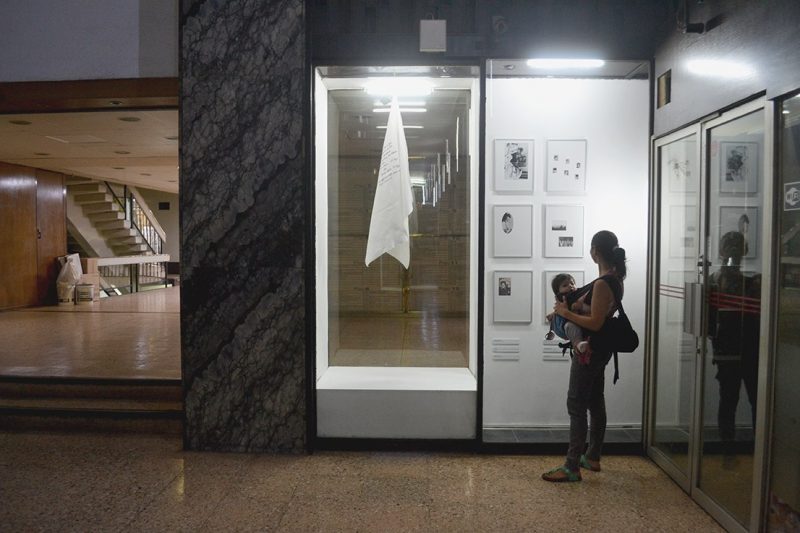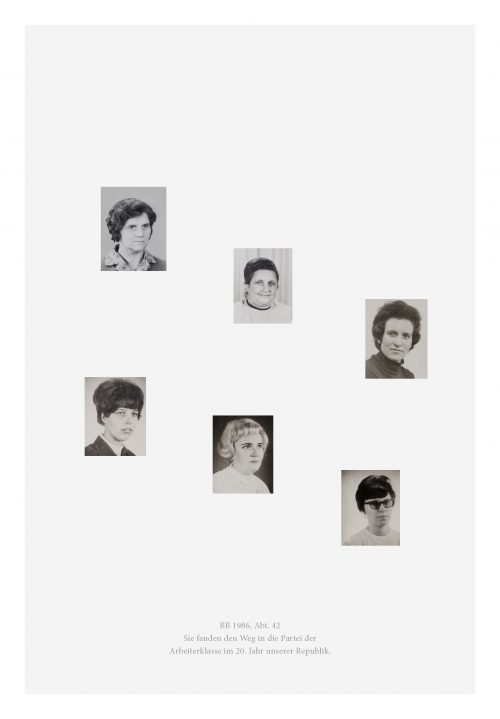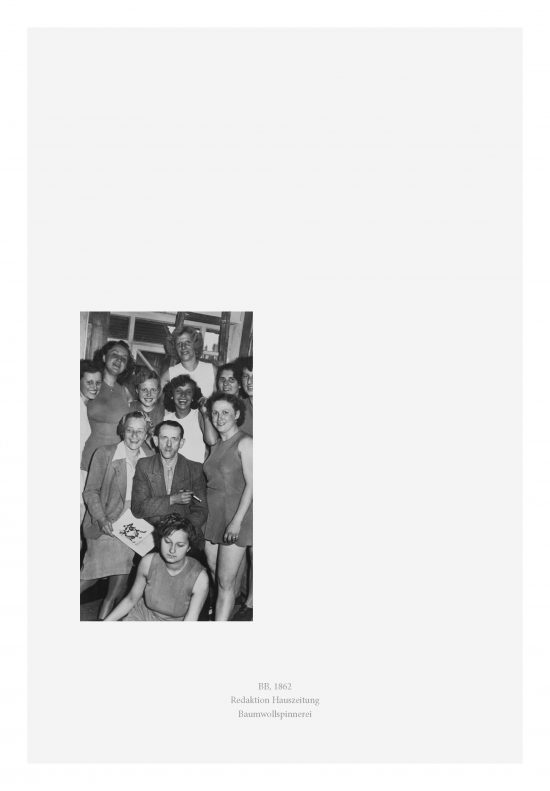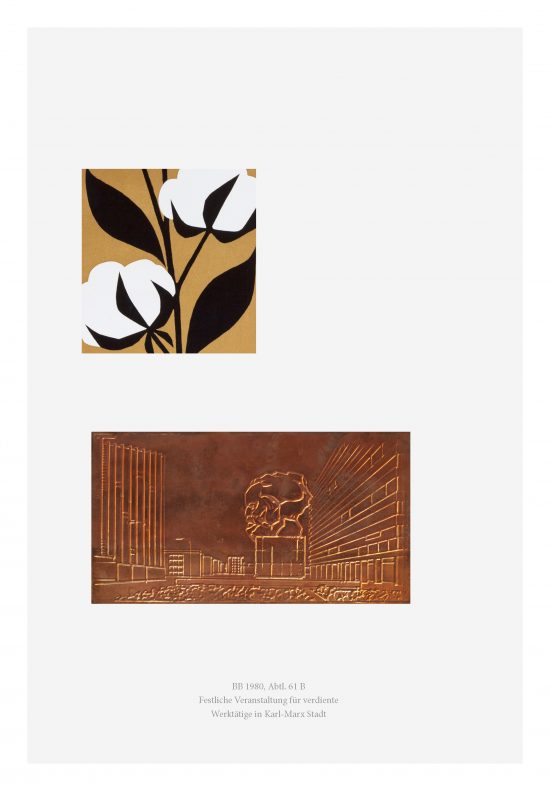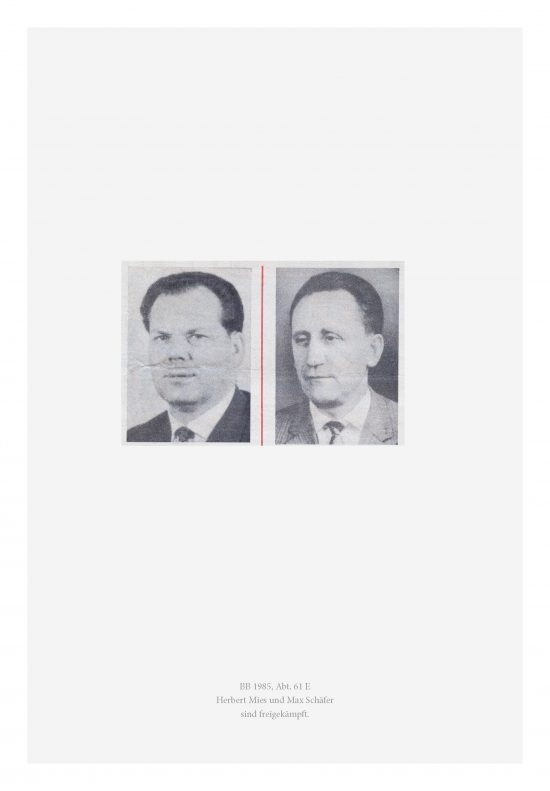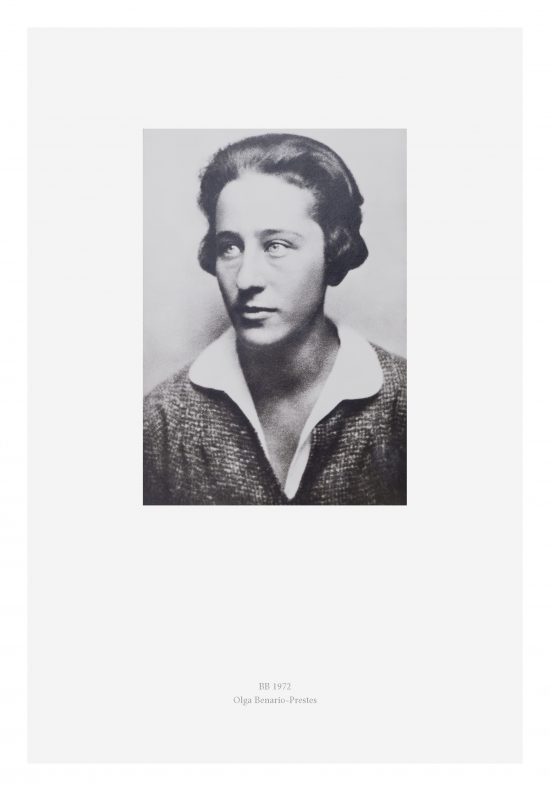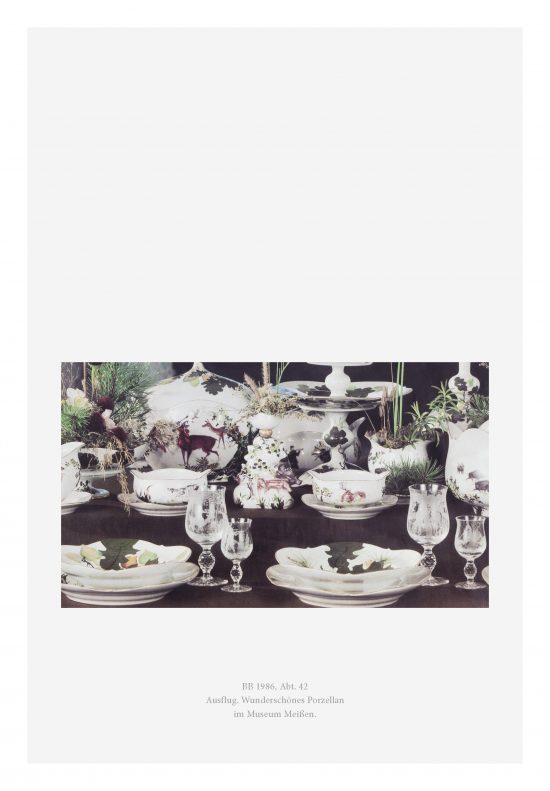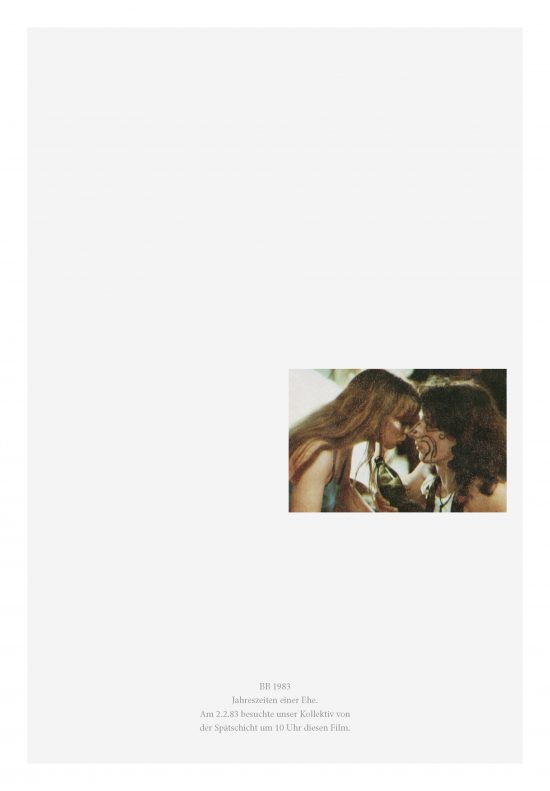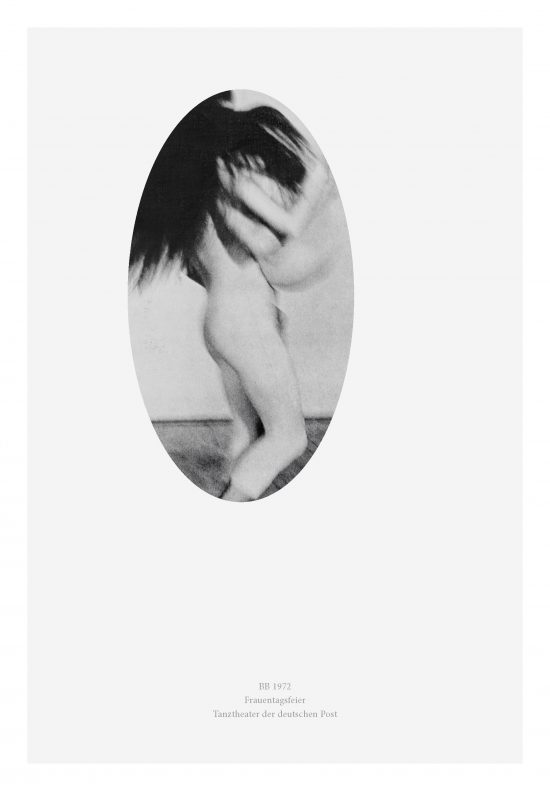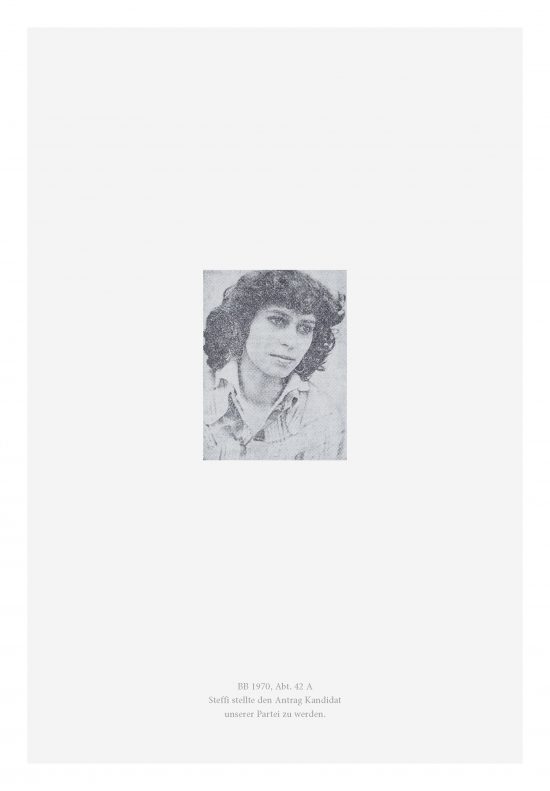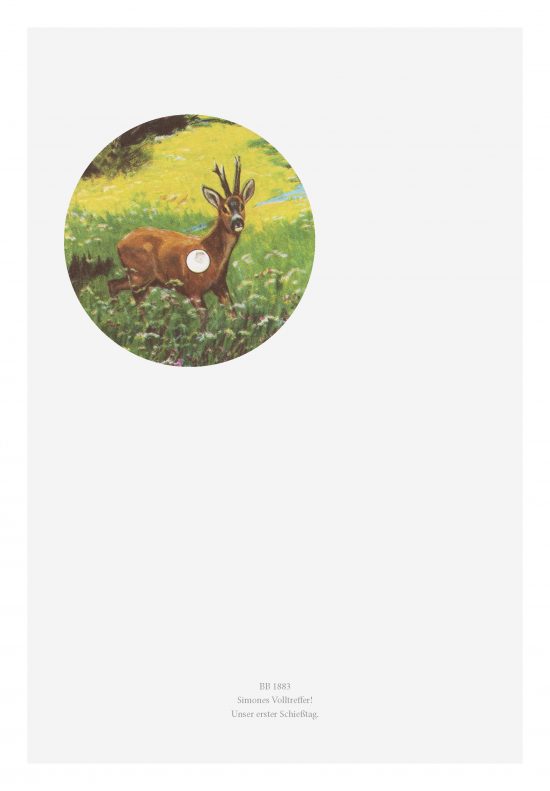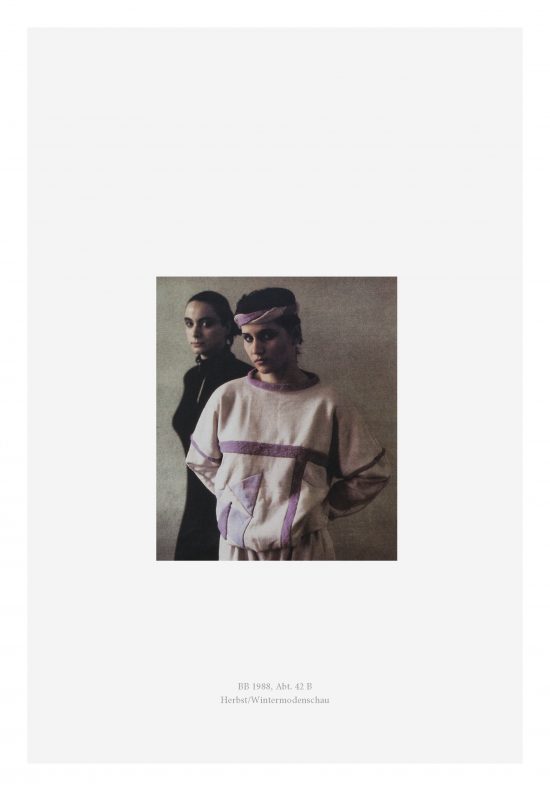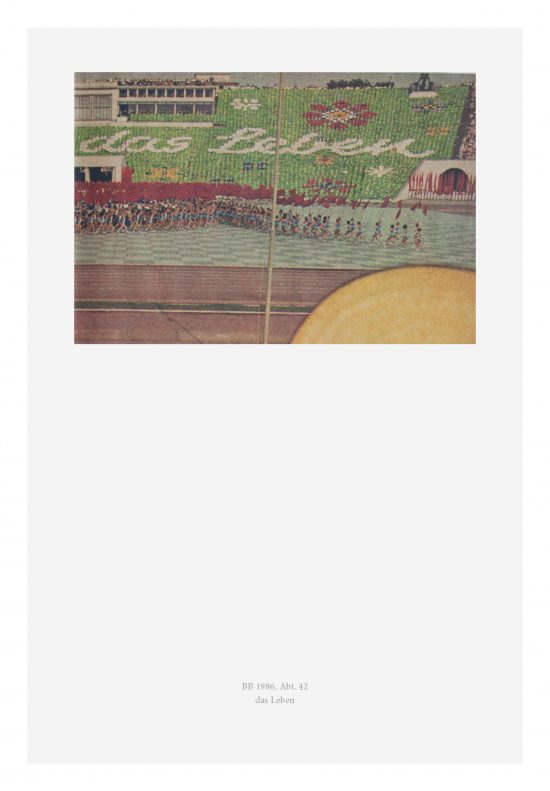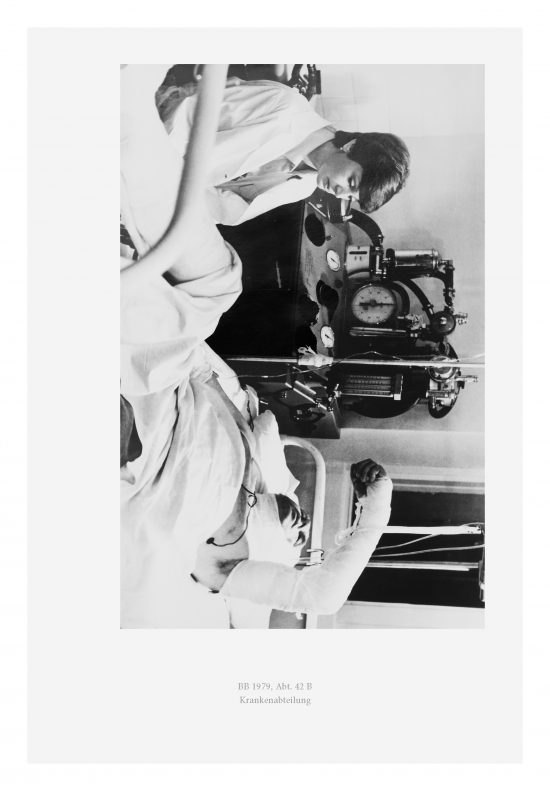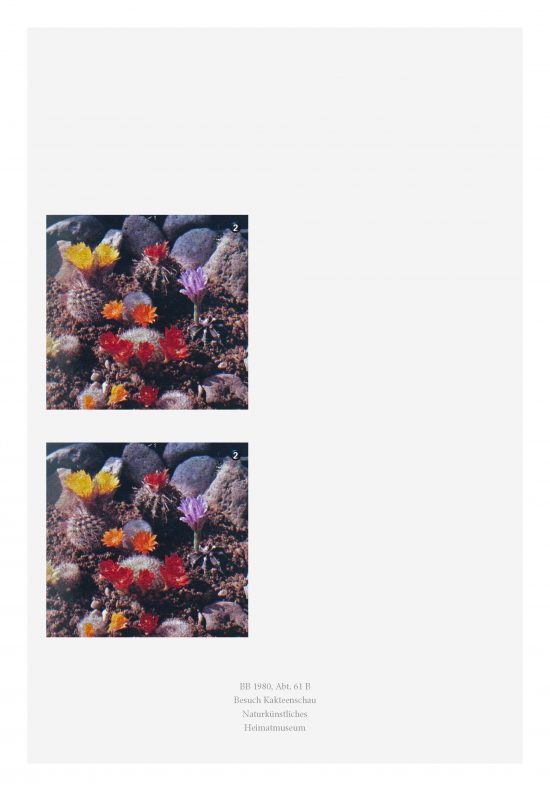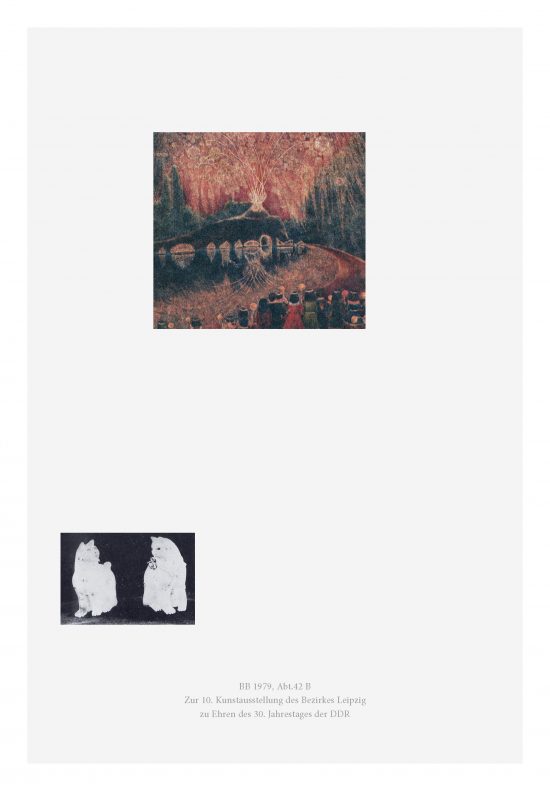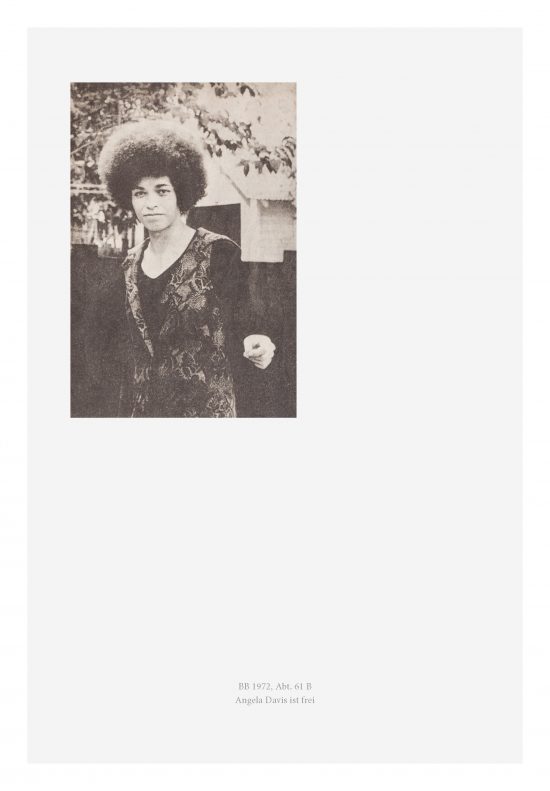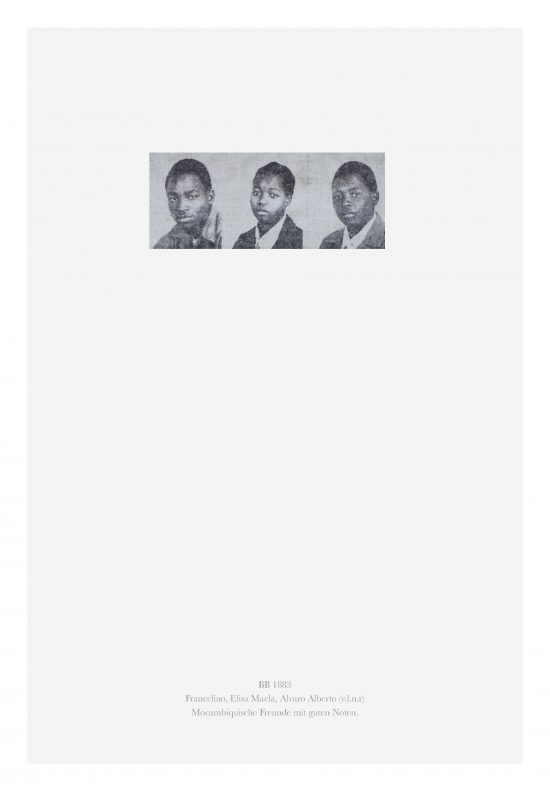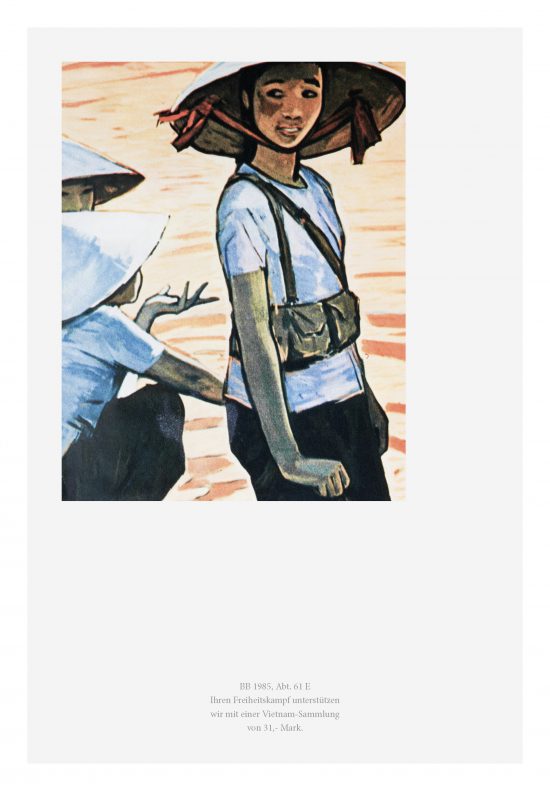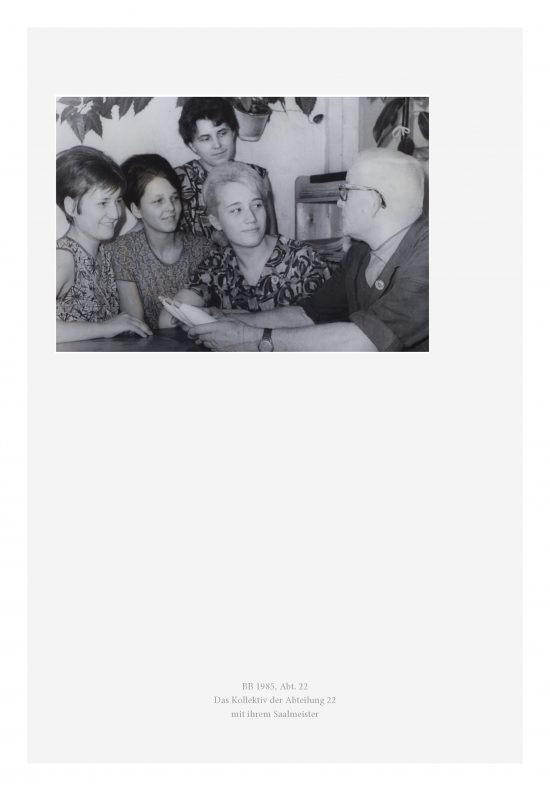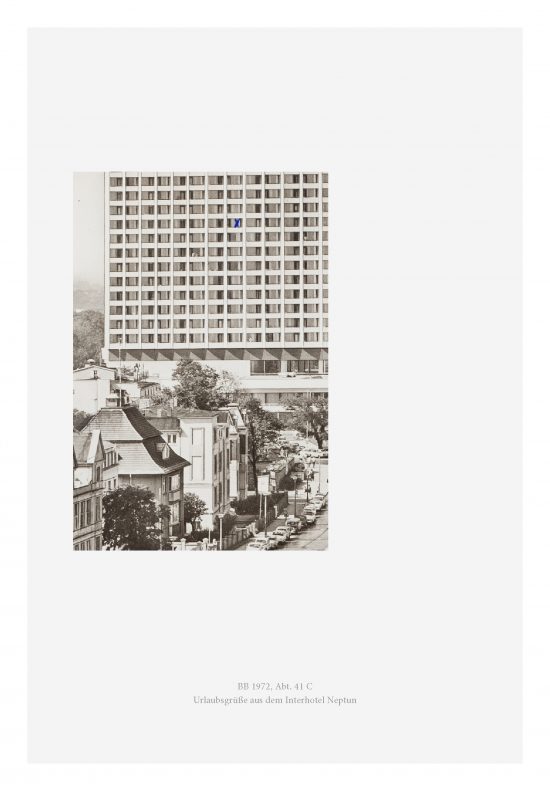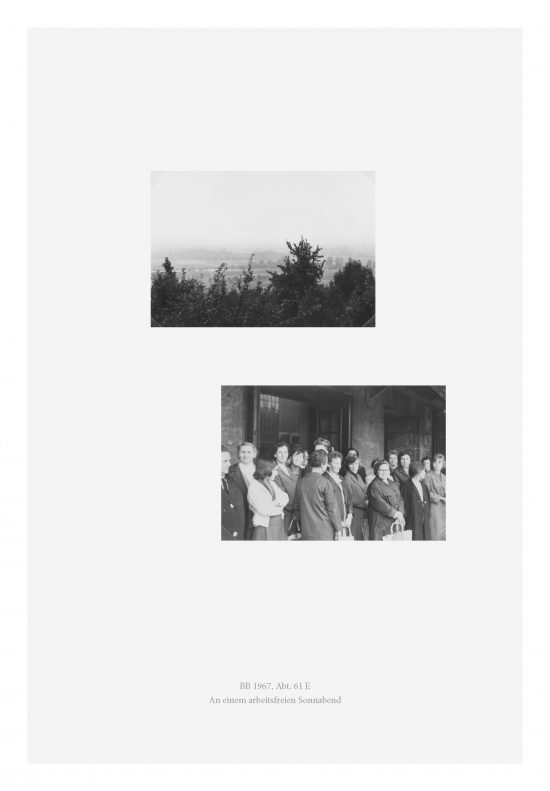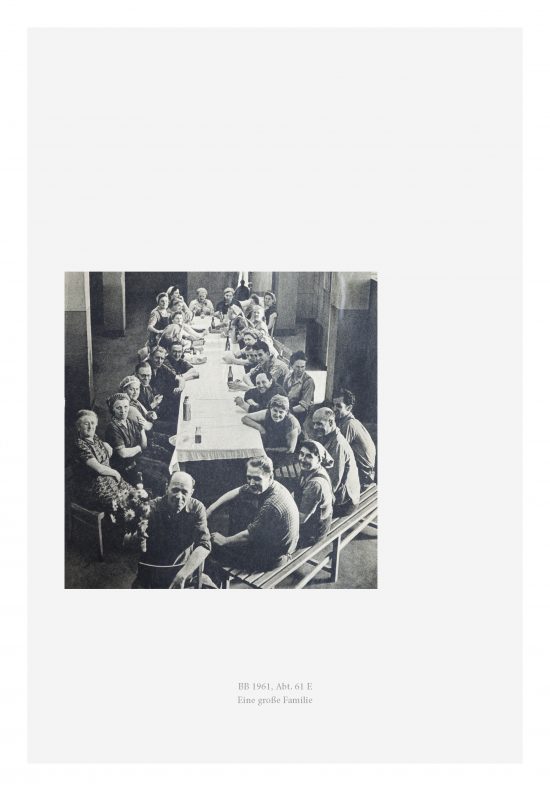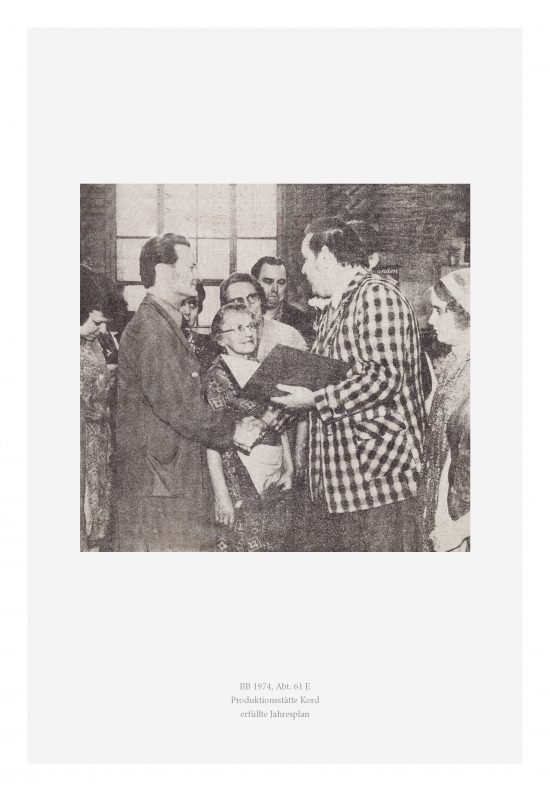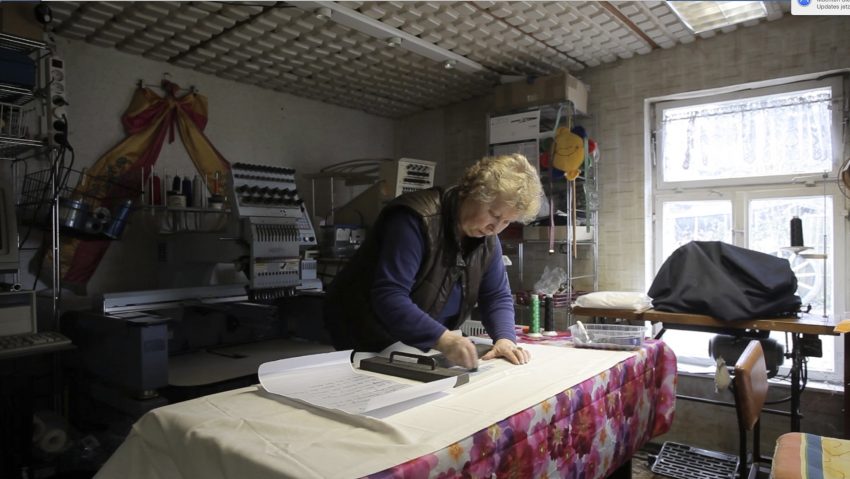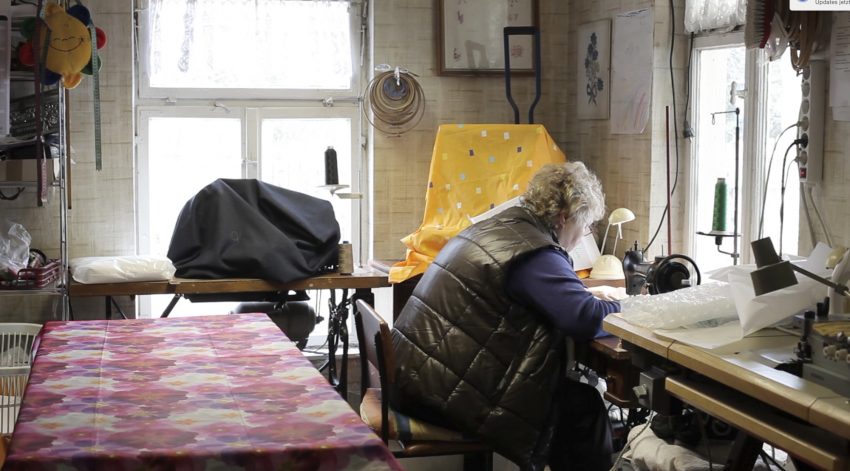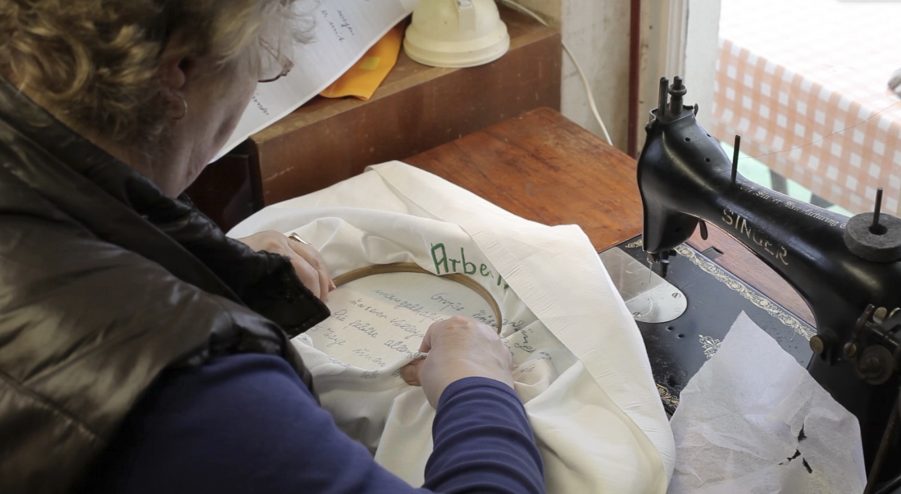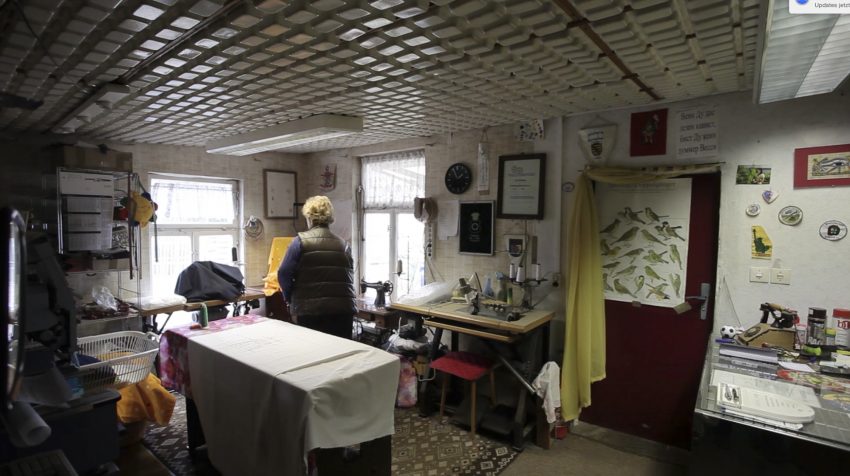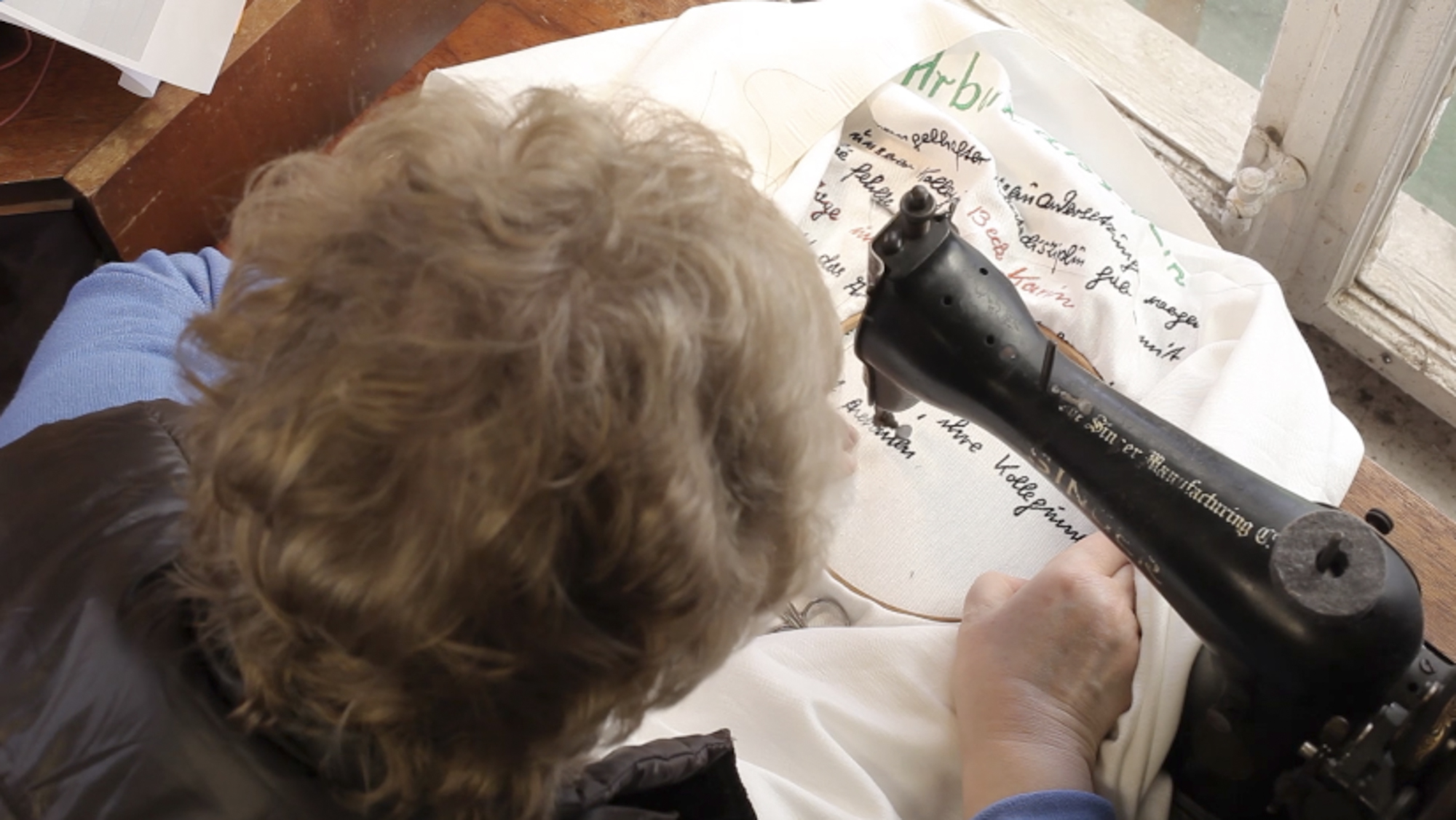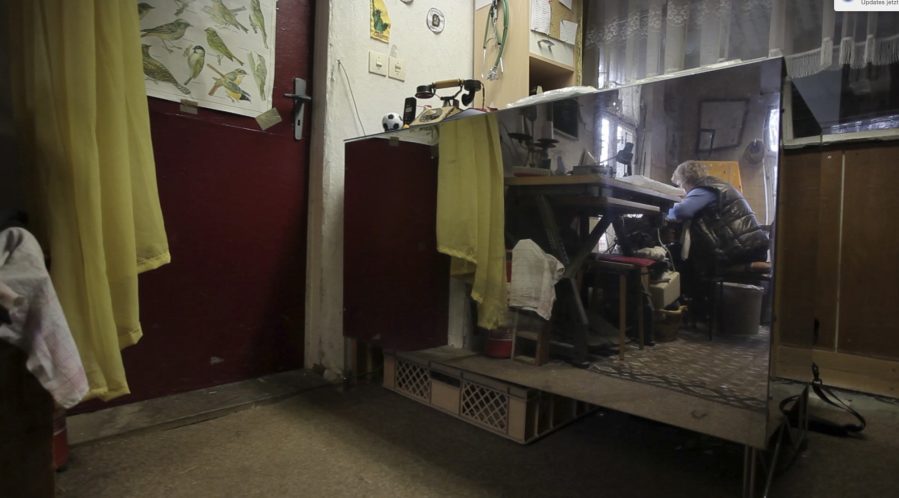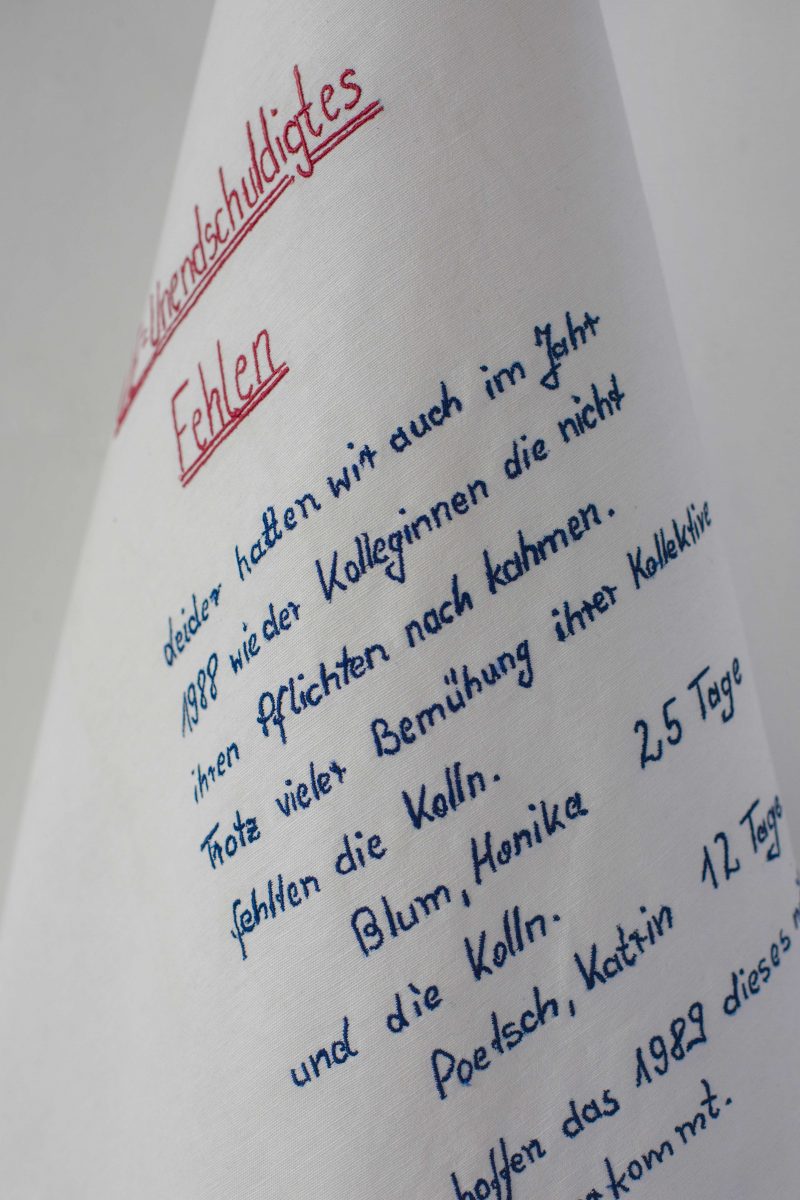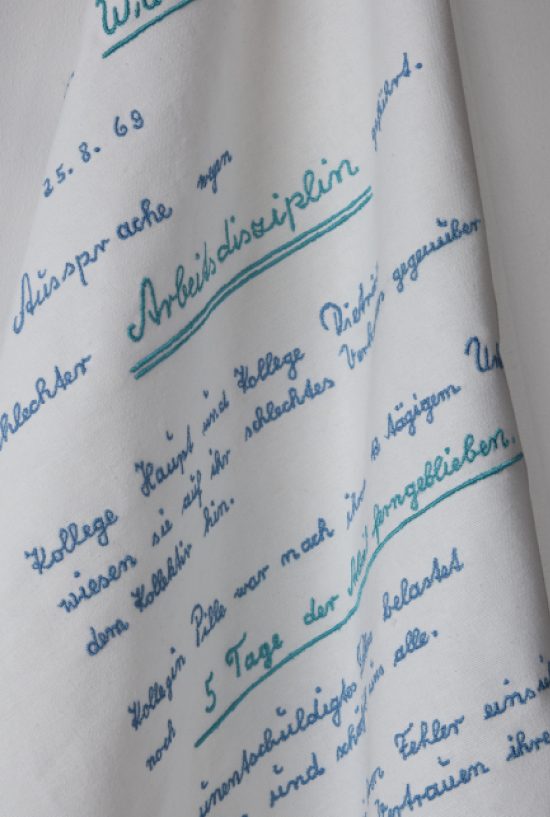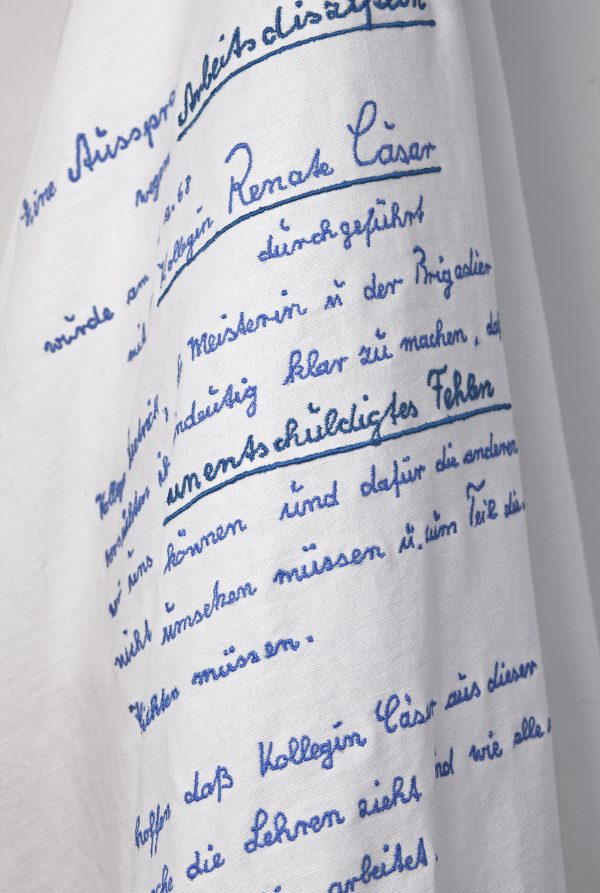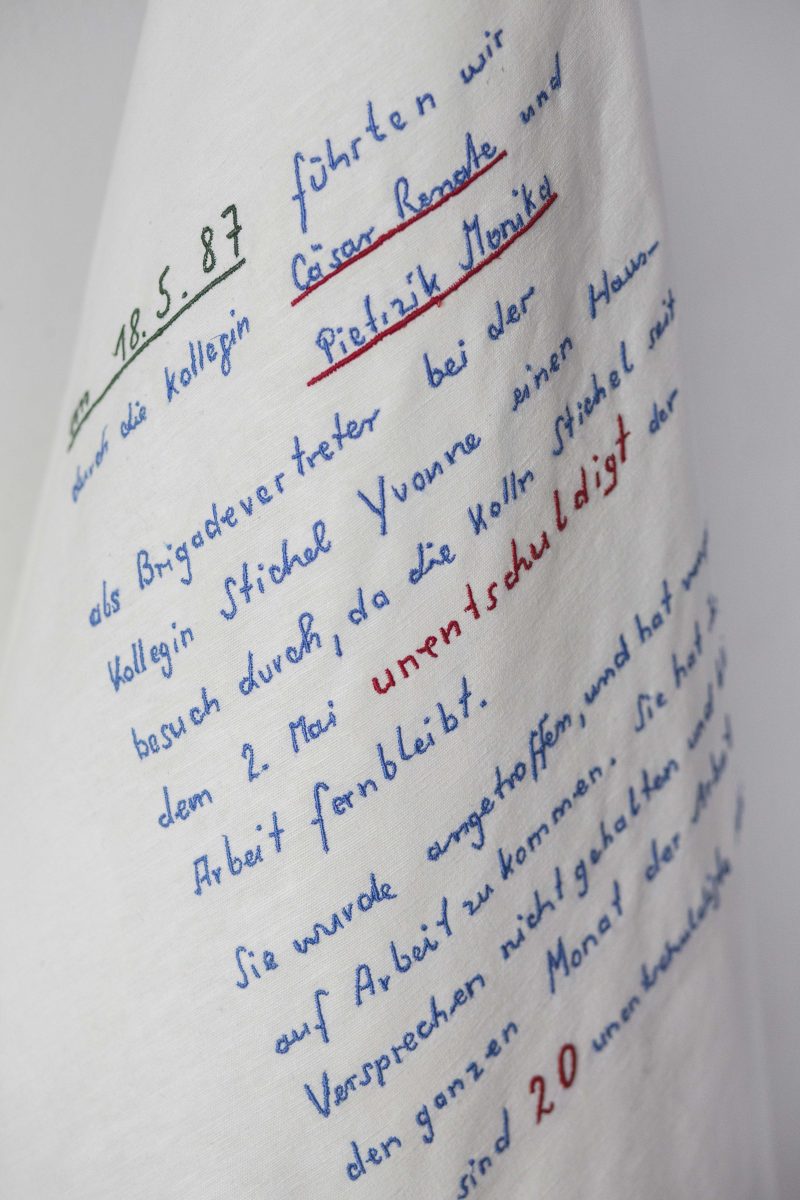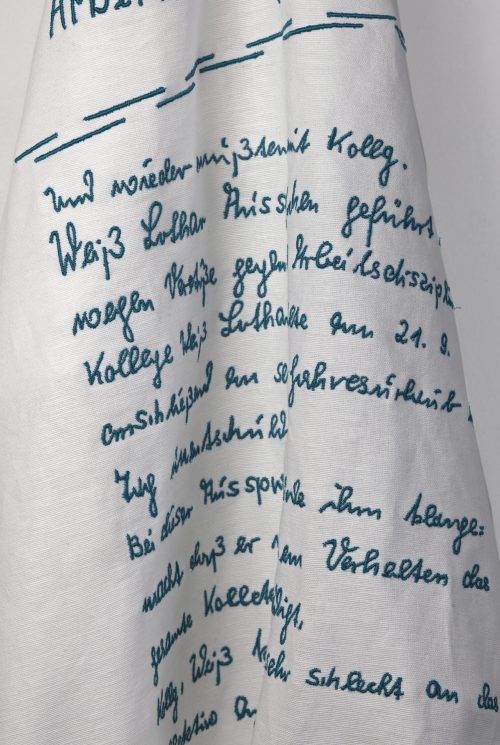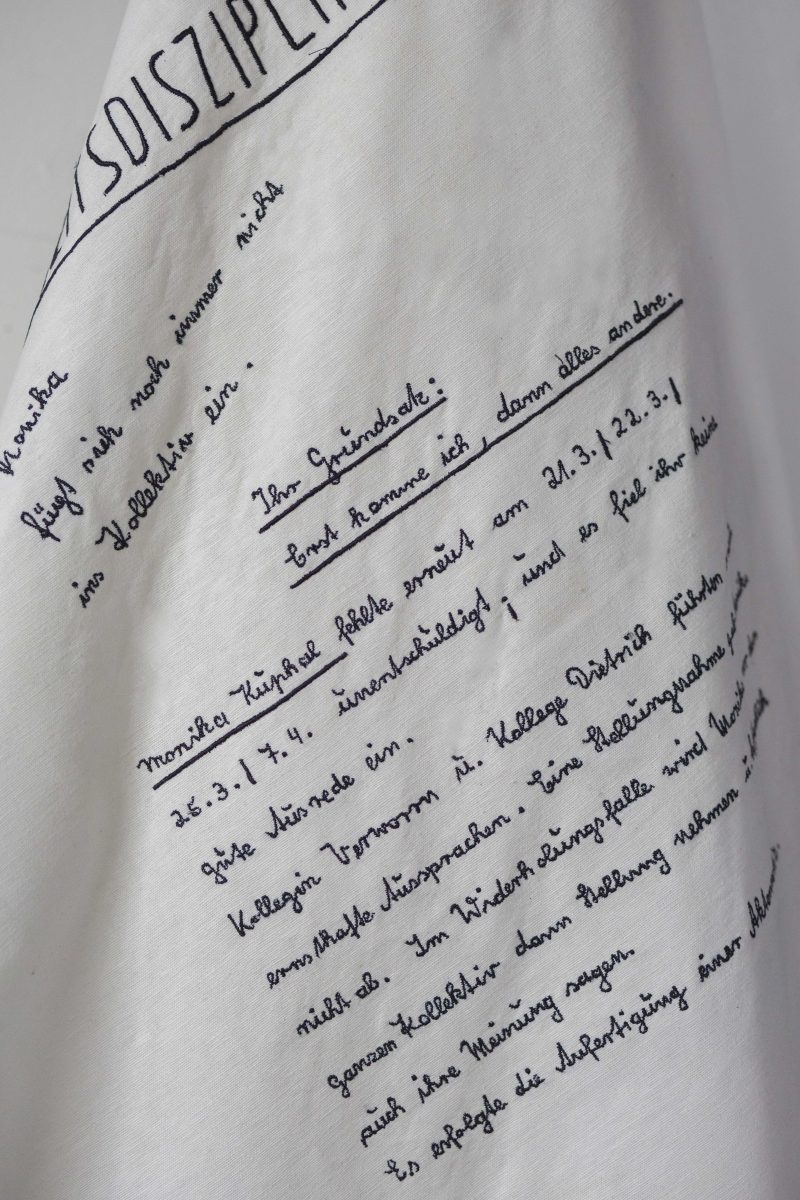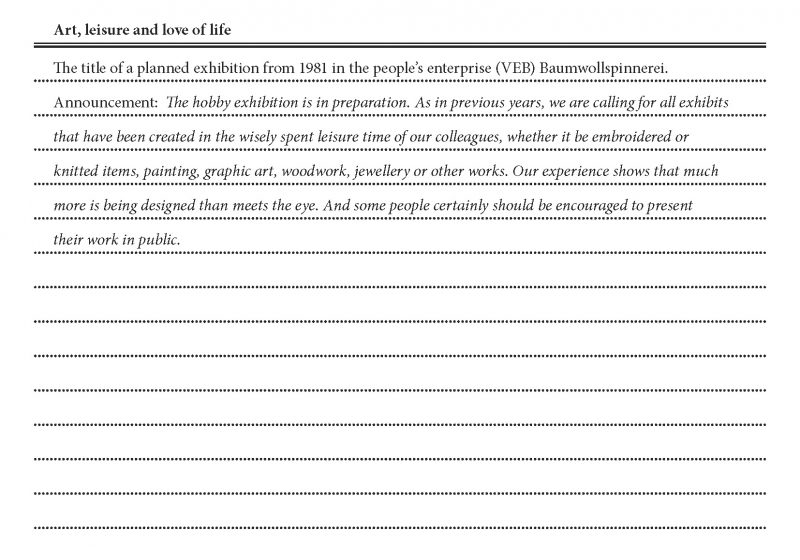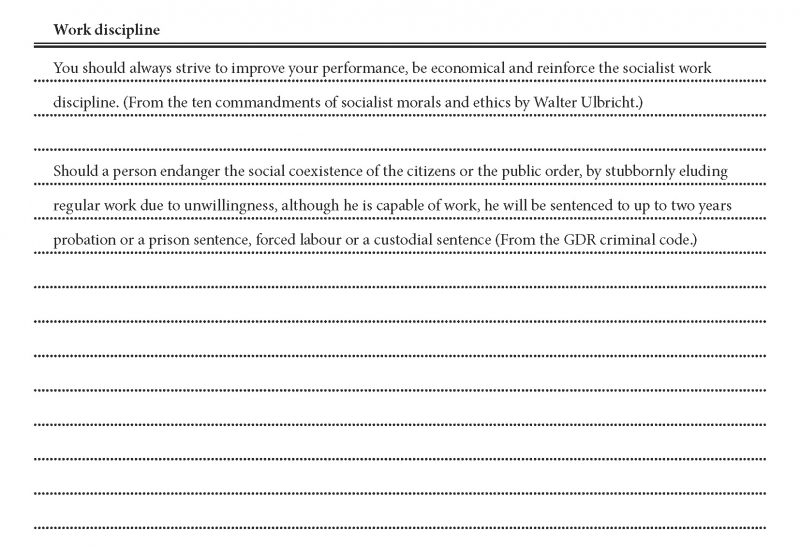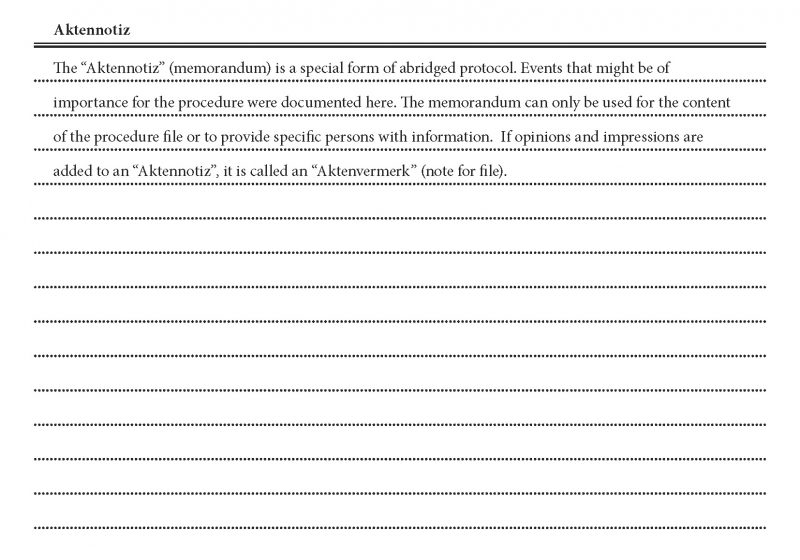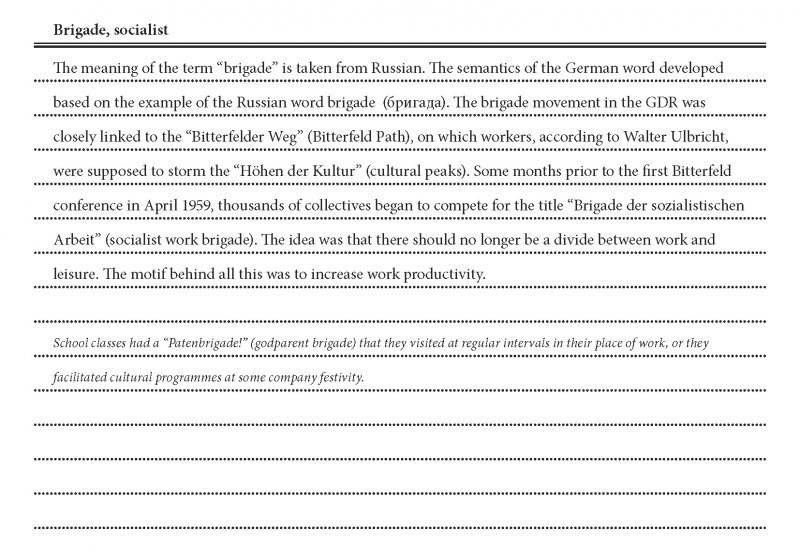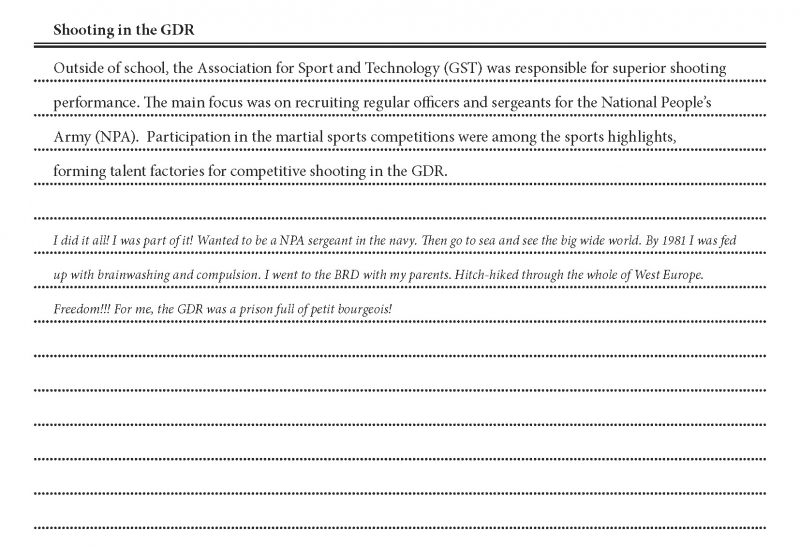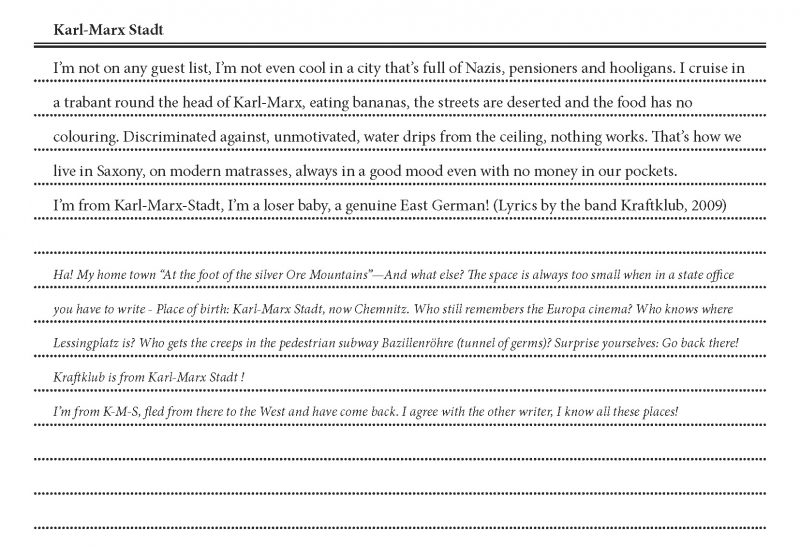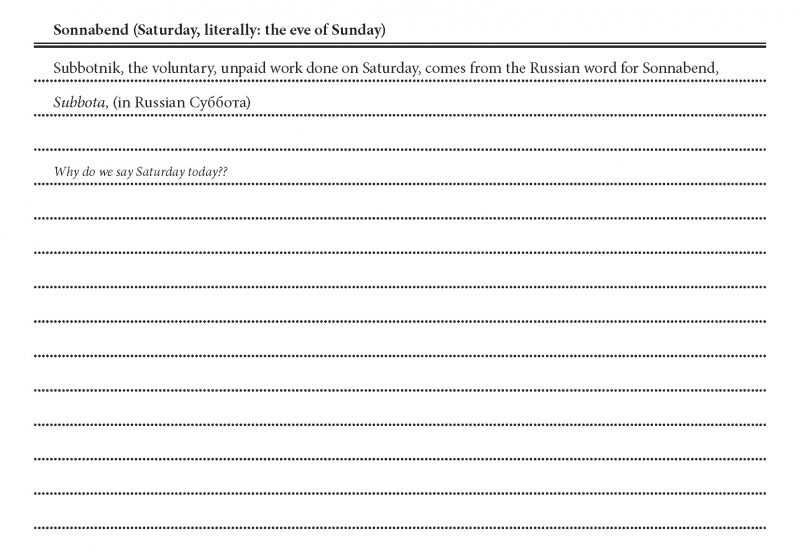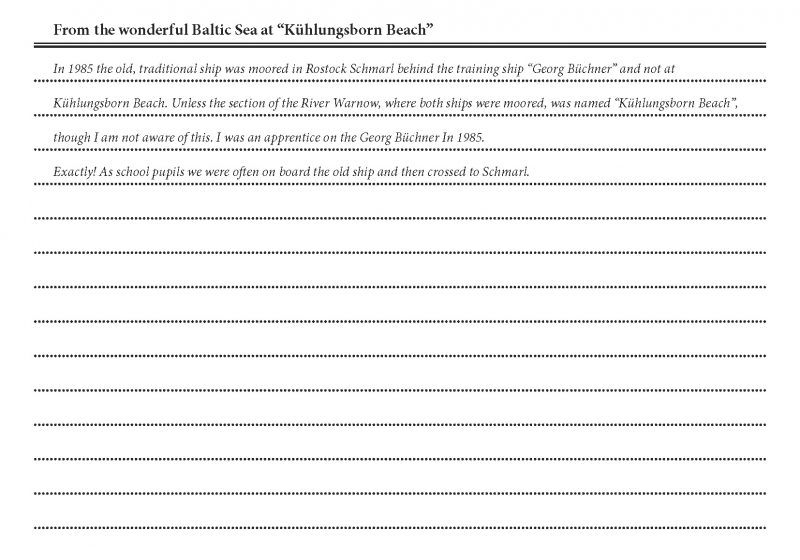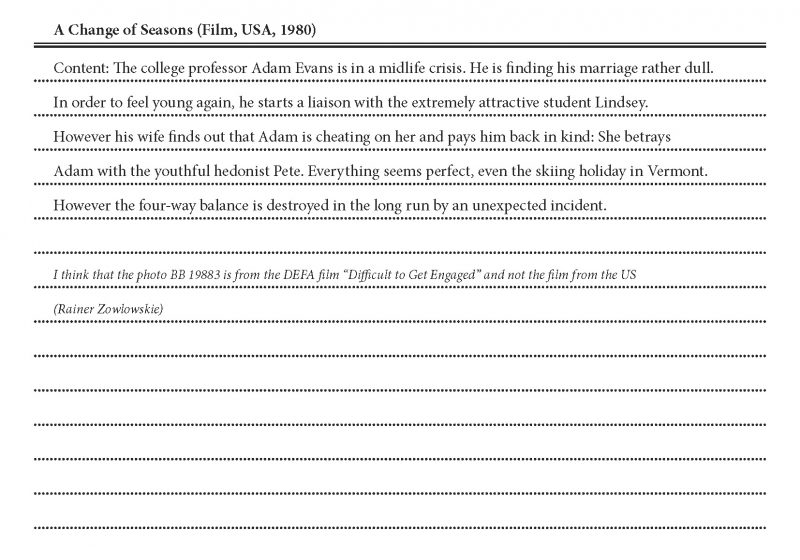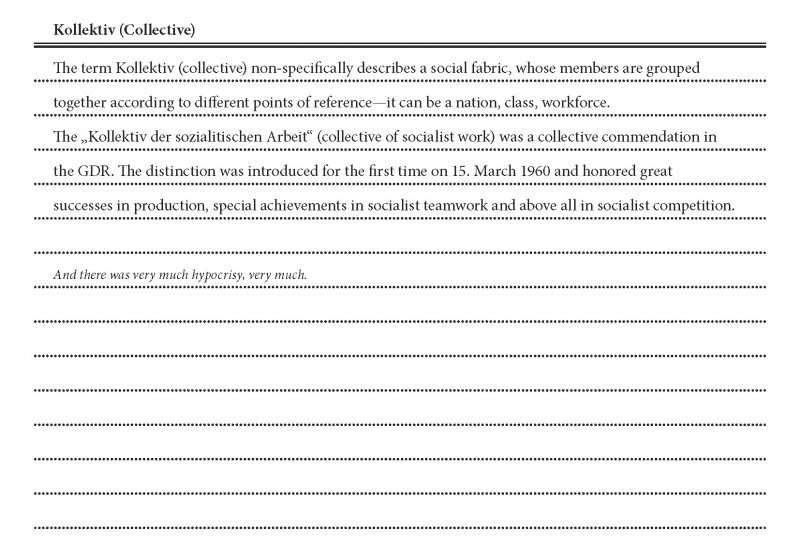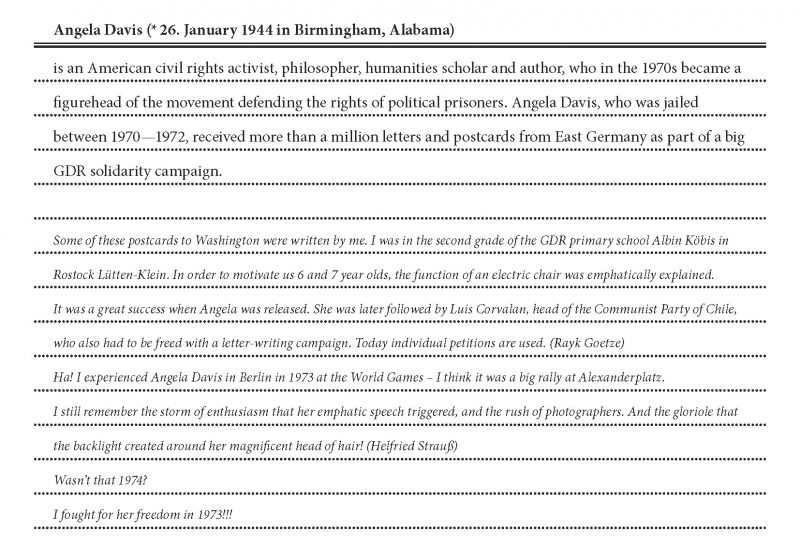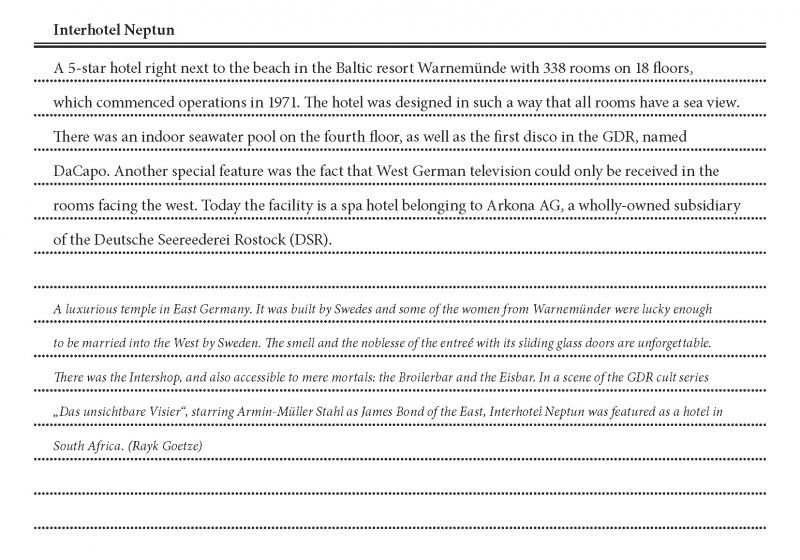Images from the Brigadebucher (brigade diaries) from the archives of the Baumwollspinnerei, a former cotton mill in Leipzig—isolated and presented in a new context. Emanuel Mathias undermines the logic of the archive and the brigade diary, which had the function of creating a literarydocumentary record of the GDR work units development, and turns the existing visual material into autonomous information carriers. By means of this transformation Emanuel Mathias not only highlights to what extent the original social and political context can be reinterpreted, but also makes our process of remembering comprehensible. He thus develops a new form of dealing with archives and helps hinder the processes of suppression and forgetting. At the same time his work takes on the form of an archive itself and uses its aesthetic to examine how memory is construed—namely dependently of archives and the documents stored in them. What remains is not only the search for the contextual information provided by photography but also the question of to what extent photography documents reality and also constantly constructs it—a question that is particularly important in the light of how we deal with archive material, in a world that is today dominated by images.
Art, freedom and zest for life, 2014
[borlabs_cookie_blocked_content title=”Video”]
[/borlabs_cookie_blocked_content]
Art, freedom and zest for life, 2014
Ann-Christin Bertrand, C/O Berlin
Proud activists, fulfilled annual plans, vacation greetings from the GDR, illustriouscollective company parties, Vietnam-collections and Mozambican friends – brigadediaries open up an unique view into the everyday life of working people in the realexisting socialism. These historical documents show the development from workingcollectives in midst of state-controlled staging and privately profane happenings.
Emanuel Mathias has chosen and arranged about 50 pages from 85 brigade diariesthat were written by the workers of the Leipziger Baumwollspinnerei between theyears of 1961 and 1989. On the basis of this special form of historical processingthe artist scrutinizes the effects of historical documents and archives in regard tothe development of individuals and society. How are memories working? How is thepast constructed? How is the collective mind developed?
Besides families, brigades and collectives had a huge political and ideologicalmeaning in the GDR. Almost without exception all adults were registered in theseunits. Writing a brigade diary was not voluntarily but mandatory. Aiming at theprotection and support of social relations and the integration of individuals into thegovernmental politics. Thus these books show highlights of work groups, theirsuccess and problems — mostly chronologically, not systematically or logicallystructured. A semi-public and semi-private staging that is reproducing the societymyth of socialism. With the fall of the GDR in 1989, also happened thedeconstruction of a national identity with its stories and social codes – thus adestabilization of a cultural common mind.
By editing the material Emanuel Mathias creates a kind of memory room with theworkArt, Freedom and Zest for Lifethat confronts the audience with pieces of theGDR past.
With regards to content, the work is split into three main topics that are interwovenwith each other: archive, memory and photography. Formally it is only two parts.For the first one, Emanuel Mathias has chosen some pages from the brigadediaries, is reproducing them and supplies them with a passepartout. By exemptingthe pictures while keeping their position on the page, he is re-staging them withoutlosing the relation to the source material. For the second part, the artist has chosenten text passages about calls to order and lets them be embroidered on cottonscarfs. He keeps the characteristics and chromaticity of the original handwrittenpassages. With this work, Emanuel Mathias develops a new form of reworking andthus counteracts the process of suppression and disremembering. At the same timehis work becomes some kind of archive itself and uses it aesthetics to examine howmemories are constructed — namely by the dependance on archives and theirdocuments. Every single picture has an inscription that pretends to be scientificallyand impartially. But the artist manages to show the absurdness of the inscriptionorder. Because references stay vague, incomplete and fragmented — just likearchives and memories itself. By isolating moments and combing them in newrelations, Emanuel Mathias undercuts the logic of the archive and the brigadediaries itself. Which original function was to medially construct the embedment ofworking collectives into society.
Sabine Weier
An immense building made of glass and concrete reaches up into the sky.In front of it, a constant flood of people is strolling back and forth along abroad street. 1972. “Holiday greetings from the Interhotel Neptun.” Platesand bowls with gold rims, ornaments and nature motifs. 1986. “Day trip.Beautiful porcelain in Museum Mei©ђen.” The Afro-American civil rights activistAngela Davis smiles into the camera. 1972. “Angela Davis is free”. Awoman and a man with long hair and painted faces are pressing their noses together. 1983. “Seasons in a marriage. On 2.2.1983 the late shift of ourcollective went to see this film.” A man is shaking another man’s hand. Nextto him, a woman is proudly smiling. 1974. “Production plant Kord fulfilledthe annual plan.”Since the German reunification, these photos have been stored with otherphotos, newspaper cuttings, postcards and illustrations in the archive ofthe Baumwollspinnerei in Leipzig. Employees stuck them in brigade booksand included notes. They add to a collective visual memory. And alsodisrupt it: In his work Kunst, Freiheit und Lebensfreude (art, freedom andzest for life), the Leipzig-based artist Emanuel Mathias does not showimages of choreographed mass events, which fed the socialist myth of societywith visual fodder and characterized how we imagine the perishedGDR to be through numerous documentary films, books of images and historybooks. Instead, he has selected much more profane images fromthe archives. Photos of Mei©ђner porcelain, of mundane buildings that hadto replace beautiful structures such as the Eiffel Tower or Golden GateBridge on postcards, also moments taken from a pop culture that wassometimes encouraged, at other times curtailed, of political heroes suchas Mikis Theodorakis or Olga BenarioPrestes, scarcely known today.Or of Baumwollspinnerei employees at one of their many carnival festivities.Mathias searches in everyday life for traces of a past reality and examinesthe mode of action of past visual languages. He has drawn these imagesfrom the diaries of brigades found in the Baumwollspinnerei, frommicrocosms that reproduced state utopia and reality for 40 years.In the GDR, a brigade was a small group of workers, a collective within astaterun company such as the VEB (nationally owned company) Baumwollspinnerei.Each brigade was defined by the role it played in the productionprocess. In thefactory city in the west of Leipzig, cotton was processed.Around 4000 employees, above all women, occupied the spinning wheelshere until production was stopped at the beginning of the nineties. Followingthis, the area became an art centre with galleries, exhibition spacesand studios. Mathias himself works in one of these studios. In 2012, theSpinnerei archiv massiv, a gallery space and a visitor centre on the site ofthe Baumwollspinnerei, welcomed visitors to the series bildarchive. In differentprojects, the artists explored the history and the transformation of theBaumwollspinnerei and the site. Mathias searched in the archive andcame across the collection of around 85 brigade books from between 1961and 1989. In such books filled by the employees, which were similar todiaries or scrapbooks, brigades from all over the country reported on theireveryday life, from achievements en route to fulfilling their planned objectives,political events and company festivities. They chose images to illustratethese events and had free reign in the design of the pages. Mathias worked
with this material and with Kunst, Freiheit und Lebensfreude created
a kind
of space for remembering, in which the viewer is confronted with fragments
of the GDR past. Even the title is a quote: it is the title of an exhibition,
which Mathias found in a newspaper cutting in one of the brigade books.
The complex work takes up three big themes that are closely linked: archive,
memory and photography. It consists of two parts. For the first part, Mathias
selected around 50 pages from the brigade books, reproduced them and
put them in passepartouts. By cropping the pictures, while at the same time
maintaining their position on the page, he presents them anew, yet still
maintaining a relationship to the material used as a starting point. In the
installation for the exhibition space the pages correspond to one another
through the way they have been hung, while in this publication they once
again take the form of a book. For the second part, the artist selected tentext
sections, in which individual workers received a written warning, and
had them embroidered on cotton scarves. He has maintained the style and
colors of the original handwritten texts.
Hence Mathias perceives the written warnings, presented in this manner, as
a special form of portrait. With the work Jacobs Karten from 2006, he
explored alternatives to the classic photographic portrait. It shows the card
game of a boy, a quartet with images of composers of classical music.
The cards are covered with traces of use and crayon. Missing cards were
replaced by copies. Mathias presents the cards from the whole card game,
which he arranged next to one another and photographed, as a portrait of
their owner. He added a further photograph, which shows the cards in
the same positions, but facedown, as an allegory for what Mathias believes
to be the shortcomings of photography. Previously, the attempt to capture
a portrait of the boy with the camera had always failed. It was not until he
discovered the cards that the artist was able to convey the boy’s personality.
Mathias also seeks to discover more about the personalities of some of the
employees through the warnings. About those who didn’t conform. The
employees who received a warning were those who, according to the official
version, damaged the collective with their behavior. In these text sections,
of which Mathias found one in about every fifth brigade, the focus was
on what fascinated the artist more and more during his research: the
emergence
of the “I” from the “We”, fractures in the collective. Those who simply
did not turn up at work, withdrew from the collective and the myth of
the socialist community propagated by the SED regime, in which not only
is everyone the same, but everyone also commits themselves to supporting
the community.
“Archive Fever” in contemporary art
Mathias’ series Kunst, Freiheit und Lebensfreude is rooted in a whole series
of works by different artists, in which these work with archives, in order
to negotiate issues concerning processes of remembering. A positive fever
has broken out in contemporary art, which has led to numerous publications
and exhibitions. This includes, for example, the group exhibition
curated by Okwui Enwezor and presented in 2008 in the International
Center of Photography in New York Archive Fever—Uses of the Document
in Contemporary Art. With works by artists such as Christian Boltanski,
Tacita Dean or Harun Farocki, the show explored artistic practices of the
appropriation and the processing of material found in archives. These
artists developed new forms of processing and counteracted processes
of suppression and forgetting. Works that deal with a communist past
from the standpoint of current postcommunist societies, like those in Kunst,
Freiheit und Lebensfreude were presented in the show. “A heightened
sense of urgency surrounds the call to remember and commemorate in
societies
where social codes of communication have been historically unstable
or preempted by state repression,” Enwezor wrote in his essay about
the exhibition.1 Such social codes of communication and the insecurities
arsing from dealing with these is also reflected in the visual language
and text excerpts, which Mathias refers to in his work, and which he sets
in relationship to one another in order to enable new interpretations.
However, Mathias not only works with the material found in the brigade
diaries.
Kunst, Freiheit und Lebensfreude itself takes on the form of an archive
and uses this aesthetic to examine how memory is constructed—it is namely
dependent on archives and the documents saved in them. He takes
an approach that is based on science, on objectivity and traceability. Each
image has been labelled: the label states the year from which the brigade
book originates, the number of the department if specified, and a quote from
the concealed notes, for example a reference to a historical event, a
company festivity or a holiday. One can read sentences like “Greetings from
Kuhlungsborn Beach at the Baltic Sea”, about “heroes of the cosmos
are looking forward to the City of Leipzig and its people with great
anticipation”,
about “Simone’s bull’s eye!” on the first day of the shoot. Mathias
shows the absurdity of the structure supposedly found in the writing. The
event referred to remains inconclusive and the space for memory to evolve
is as patchy and fragmentary as the archive itself. For Enwezor, this approach
to the archives and the role they play in collective memory is one of the
important accomplishments of these works of art: “Here we witness first
hand how archival legacies become transformed into aesthetic principles,
and artistic models become historicizing constructs, so that in the works,
and the ways in which they are arrayed before us, we experience first
hand their effects.” 2
Michel Foucault, whose Arch
К
ologie des Wissens is constantly referred to
in discourses about the exploration of archives in contemporary art,
goes a step further and elevates the archive to the “law governing what can
be said” 3 and to a “general system of formation and transformation of
statements.” 4 If one transfers this concept to memory, one could view an
archive as the law of what can be collectively remembered, as a general
system of formation and transformation of memories. Against this background,
Mathias’ work takes on a function that goes beyond a mere critical
exploration of the past: it forms and transforms memory and hence
becomes part of a lively culture of remembrance.
Letting the story evolve: art and cultural memory
Aleida and Jan Assmann also deal with the way memory functions. The
literary critic and Egyptologist presume an interaction between individual
and collective processes of remembrance. This is where the communicative
memory is located, which is based on personal experience and above
all conversations, hearsay and newspaper reports. It evaporates after
80 to 100 years and leads, as time moves on, to an increase in
writtenremembrance work and in archives. Here, the cultural memory is also
located,
which must rely on storage media such as written documentation
or photographs, as there is no longer anyone who can be asked personally.
Cultural memory above all serves the collective construction of identity
in the present as it provides possibilities that refer back to a collective past.
Together they form the communicative and cultural memory of all the
recollections
of a community, in other words the collective memory.5
Archives filled with storage media, such as the brigade diary archive in the
Baumwollspinnerei, have become central locations for cultural memory
in the twentieth century. Communicative memory still plays an active role
in the remembrance of the GDR past. However, this past is a special
case: The socialist myth of society evaporated with the decline of the state.
The corresponding life is not to a large extent extinct and forced to rely
on traces found in our cultural memory. With the deconstruction of an entire
national identity including its myths and social codes, an entire cultural
memory was destabilized and with it also individual identities and lastly the
communicative memory of the present. In Kunst, Freiheit und Lebensfreude,
Mathias explores both aspects with regard to the remembrance of the GDR.
The work examines the interfaces of communicative and cultural memory
as well as uncertainties within this network. He perceives his work as
something expandable: he is seeking to meet contemporary witnesses, hold
interviews and then possibly incorporate this material in his work.
In an essay about the exhibition Das Gedächtnis der Kunst—Geschichte
und Erinnerung in der Kunst der Gegenwart (2000), Aleida Assmann
stressed that the past does not emerge until one refers to it repeatedly. She
allocates the artistic appropriation of archive material a central role in the
recollection processes. “Whether it is writing or photography, which existsas a
form of storing the material for a longer period of time, lively recollection
is
in danger of being lost. […] Hence in order to reactivate the collective
memory,
we need an active form of practice, embodiment, appropriation.”
6 Works
of art play an important role in the renewal of memory, Assmann continued,
as they question the rigid boundary between what is remembered and what
has been forgotten and is constantly shifted by surprising designs.7
Since the 1970s, art has served as a model for dealing with and processing
trauma, for example the holocaust. When artists explore the past, they
probe in old wounds, question identities and discourses and direct attention
to things that historians, bound by the specifications of science, often
do not want to articulate. The importance of a culture of remembrance that
is alive, enabled by artistic works such as Kunst, Freiheit und Lebensfreude,
is also shown by the debate that flares up again and again around
the topic of the new monuments and memorials, which literally cast memory
in stone, freezing it.
Mathias’ work aims to create a communicative connection. In his own
subjective
and biographically influenced artistic practice he transports fragments
of cultural memory into communicative memory. However, he also
opens up the process for the viewer: the presentation of the photos in this
publication invites the viewer to make associative interconnections between
the fragments and the intentional gaps. These are the fragments of a potential
past, ideas that the viewers can develop themselves and which they can
piece together to create different textures, according to individual experience,
biographies and hearsay. Mathias enables the viewer to have a specific
experience of remembrance and constructs many potential pasts.
Photography, a medium of remembrance?
What might at first glance seem like a reconstruction of past realities, when
we look more closely turns out to be a kind of construction kit for an imaginary
reality, which is in fact constructed by the viewers. No other medium
is more suitable for evoking such an imaginary reality than photography.
The photos chosen by Mathias are the most powerful building blocks in
Kunst, Freiheit und Lebensfreude. They give the work a documentary
character,
creating confusion at the same time, and they show past aesthetic
realities, provoke associations, suck the viewers in so they cannot escape.
Since the existence of photography, it has played a leading role in the
storage of cultural remembrance. Public and private, analogue and digital
archives are full to the brim with photos. They function as traces of the
past, are perceived as mediums that store history per se. One only need
think of illustrated books with titles such as “A hundred years in pictures”.
Or about how long the photographic image above all was perceived as a
storage medium before it was able to gradually establish itself as an artistic
medium from the 1970s. However, are photographs really suitable as carriers
for cultural remembrance?Roland Barthes has clearly rejected the analogy
between photography and
remembrance and even goes a step further: “Not only is the essence of
a photograph never remembrance […], it is actually a hindrance and quickly
becomes a countermemory. […]Photography is violent, not because
it shows acts of violence but because each time it is viewed, it fills the gaze
with violence […].“ 8 With view to the increasing flood of images that has
tossed and turned through the archives of the world for years, according
to Barthes’ theory, one might also allege that collective memory becomes
a collective countermemory. Aleida Assmann also addressed the problem
of the paradox character of the medium. For the same reason, she calls
for an active practice, such as an artistic one. However, Assmann also
stresses that collective memory would not be possible without a storage
medium such as photography.9
A found photo is not a carrier medium for the past that it refers to. It is the
substance of the archive and that which according to the archive is worth
saying or worth remembering. And it is above all a selfreferring aesthetic
object that can serve as the material starting point for an imaginary reality
that refers to this past. Mathias uses it in this way, and it is also used by
the viewer of Kunst, Freiheit und Lebensfreude in the same way. In the
process, each individual photo presented in the context of the overall work
remains a strong, fascinating, captivating and engaging aesthetic object.
Mathias leaves as much space as possible, in order that it can have its own
impact. He elevates the profane, found image to a sacred status when
he presents it as art in the gallery space or in this publications. His selection
on the one hand draws on the interest in the breaks in the collective
memory mentioned at the beginning of this text, an interest that increased
during the research, and on the other hand the gaze of the artist, who
for years and through a series of different works, has dealt with the ways
in which photographs function.
The individual in the collective
Very different visual languages have an impact in Kunst, Freiheit und
Lebensfreude. For example fashion photography, postcard idylls, images
from daily newspapers, portraits and amateur pictures. The latter in particular
provide a rich source in the search for the fractures in the collective,
for the I in the We. The amateur photos have been taken in everyday work
settings, as well as special events such as company festivities. The I is clearly
visible on a picture of the editorial team of the company newspaper
of the Baumwollspinnerei, shot in 1962. A pleasantly smiling group is posing
next to one another in three rows for the photo. Only one member of the
editorial team is sitting on the floor. It is a young woman with short curly hair.
Her head is far below those of her colleagues. Everyone is smiling happily
at the camera. Only her gaze looks dreamily downwards. It seems as of
she does not belong to the group and has ended up in this group photo
by chance. She really stands out, says Mathias.Maybe this impression
corresponds to that what Roland Barthes calls “punctum”,
something coincidental about a photograph that touches the viewer
in some way or other. Barthes’ punctum is at times a moving moment, at
other times a perplexing one, which he above all finds in amateur
photography.
10 It allows space for things to happen by chance. Neither the result nor
the impact can be controlled completely. At the end of the day, the punctum
of a particular photograph remains subjective. Yet many of the pictures
selected by Mathias’ for Kunst, Freiheit und Lebensfreude provide something
that could be understood as punctum, such as the member of the
company editorial team who stands out from the rest, or the plaid jacket of
a someone receiving an award. In this picture it was this jacket in particular
that attracted Mathias’ attention, giving him special access to the image.
If one transfers Barthes’ idea to visual memory as a whole, which is
dominated
by the propagandistic visual language of the GDR, there are also
images in Mathias’ selection that appear like a punctum within this visual
memory. This includes the fashion photography from 1988. It could have
been taken from a fashion magazine such as Sibylle. A young woman is
looking straight at the camera. She is pictured from the hips upward and
is wearing a fashionable, lilac sweater with geometric patterns and a matching
pair of trousers. Her hair is tied back with a ribbon made of the same
material. She stands out in the foreground in comparison to another woman,
who is standing behind her on the left and wearing inconspicuous
black clothing. The latter seems like a shadow and the similar stance of the
two strengthens this impression. Here, it is very much about the I, which
manifests in the fashionable presentation of the individual. The workers who
are visible on the other pictures, at work in the Baumwollspinnerei, are
wearing the traditional sleeveless overalls that many women wore for work
in the GDR but also often in their everyday life. The artistic compositionof the
photo makes it stand out from the rest of the images. In fashion and
also in fashion photography a kind of visual counterculture developed,
which created space for the individual.
A blackandwhite photograph of a dancer dating back to 1972 can also be
perceived as a punctum in the collective visual memory. It is entitled
“Women’s Day festivities, German Post office dance theatre”. The image
has an oval shape that fits the body of the dancer. The figure is blurred,
the photograph shows it in a rotating movement, sending the long dark hair
flying. The upper part of the figure is not easily recognizable. It looks as
though the figure is holding another dancer in its arms and swinging it
through the air. At first glance the figure seems to be naked, however the
hem of a skintight, lightcolored suit is visible at her calf. The untamed,
wild aspect of this image is a little perplexing. It conveys a feeling of artistic
freedom that, as we know, did not exist officially in the GDR. It triggers
associations with 1970s avantgarde action and performance art above all
in the Western world, which could be openly critical and advocated the
complete freedom of the individual. Like other images shown in Kunst, Freiheit
und Lebensfreude it seems as though it has slipped into the image
by coincidence, like a foreign body in the collective visual memory.
By taking these moments from the brigade diary archive, isolating them and
putting them into a new relationship to one another, Mathias undermines
the logic of the archive and the brigade diary, whose function it was to
construct
the worker’s collective and embed it in society through media. He
draws attention to the breaks in this constructed collective and hence also
the ruptures in the processes of remembrance that construct identities
in every present moment. In a medium that is a carrier for cultural memory
he finds the traces of the communicative memory, the direct experience.
Kunst, Freiheit und Lebensfreude is also a draft showing how we can use
archives and the photos found in them, in order to remember.
Mathias sensitizes the viewer for the potential inherent in the perplexing
moment. One only needs to allow oneself to be perplexed. For example by
the page in the brigade diary that shows six passport photos in symmetric
columns. Six women can be seen on the photos and the title indicates
that the brigade diary is from 1969. He also quotes the corresponding
entry: “They found their way to the Worker’s Party in the 20th year of our
republic”. The gaze speeds across the page and jumps hectically from
image to image because it is overwhelmed: Passport photos and portraits
are reserved for the individual. This what we have learned. Yet here it seems
certain that a group image is being established, a group that has in common
the fact that it not only joined the brigade but also the SED. However, the
gaze does not manage to discern a group. When it pauses, then on a single portrait. Then it begins to study the facial expressions, the hairstyles, this pair of glasses or that collar. The I stays I and the We remains a construct
1 Archive Fever—Uses of the Document in Contemporary Art, exhib.cat.
International Center of Photography,New York, G.ttingen 2008, p. 37. 2 Ibid., p. 21 f. 3 Michel Foucault: ArchКologie des Wissens, Frankfurt a. M.2013, p. 187. 4 Ibid., p. 188. 5 Cf. Jan Assmann: Das Kulturelle GedКchtnis. Schrift, Erinnerung und politischeIdentitКt in fruhen Hochkulturen, Munich 1997, p. 48 ff. 6 Das GedКchtnis der Kunst. Geschichte und Erinnerungin der Kunst der Gegenwart, exhib.cat. Historisches Museum and Schirn Kunsthalle, Frankfurt a. M. 2000,p. 26. 7 Ibid., p. 27. 8 Roland Barthes: Die helle Kammer. Bemerkungen zur Photographie, Frankfurt a. M.1989, p. 102. 9 Frankfurt a. M. 2000 (see note 6), p. 25 f. 10 Barthes 1989 (see note 8), p. 33 ff.BibliographieAssmann, Jan : Das Kulturelle GedКchtnis. Schrift, Erinnerung und politische IdentitКt in fruhen Hochkulturen,Munich 1997. Barthes, Roland : Die helle Kammer. Bemerkungen zur Photographie, Frankfurt a. M. 1989.Foucault, Michel : The Archaeology of Knowledge, Routledge 1972.Archive Fever—Uses of the Document in Contemporary Art, exhib.cat. International Center of Photography,New York, and Steidl Publishers, G.ttingen 2008.Das GedКchtnis der Kunst. Geschichte und Erinnerung in der Kunst der Gegenwart, exhib.cat. HistorischesMuseum und Schirn Kunsthalle, Frankfurt a. M. 2000.
Annette Schürmann
The concept behind the exhibition “Talents” is a support program for youngphotographers and art critics. It is has been advertised annually since 20016 by theC/O Berlin und is financiallysupported by the founding member Deutsche BörseAG. The topic of the announcement is determined and usually has a wide range ofpossible interpretations. The selection committee consist of curators, members of visual studies, journalists and photographers. Stated in the self-description is therating of the transformation of a given topic into a “contextually and aestheticallyhigh-quality” work. Hence the announcement of the year 2013 offered a wide rangescope for the applicants.
The topic “Memories” was to artistically question the contradiction betweenmemories and their depiction in photography – and their accompanying gapbetween (evoked) events and its visualizing. A topic that the research of “VisualHistory” evolves around 20 years theoretically and methodically in Germany. It wasclear that historians would be suspiciously observed by art scholars who claimed itto be their field of action. Especially in the beginning, neighbouring disciplines weresceptical about the productive scientific handling of visual sources by members of “Visual History”.
The announcement of the topic “Memories” was awarded to Emanuel Mathias —besides the other awardees Iveta Vaivode, Marc Beckmann, Krzysztof Pijarski —who was born in 1981 in Halle. His work with the titleArt, Freedom and Zest for Lifecan been found recently at the exhibition space of the C/O Berlin, close to theBahnhof Zoo.
The artist has been studying photography in Leipzig and has been a master studentwith Tina Bara. The 33-year old has already had some success in the contestedfield of artistic photography. He was awarded the Marion-Ermer-Award in 2011 [1]and the SYN Award in 2013 [2]. In the year of 2015 he was financially supported bythe Institut für Auslandsbeziehungen (ifa) and theGoethe-Institut Jakarta to do aresearch trip to Indonesia for his project “Decisions about an appropriatedistance” [3]. And recently he is on the long list for the award of the National Galeriefor Young Art. [4]
Archive-feverThe topic “Memories” is a wide field that bustles with historians. The work ofEmanuel Mathias shows that it is worth to raise your eyes from the desk to learnabout how other professions are working with source material. Which social andeveryday historians already used in the 1990s and which can still profit frommemories today. Material that is mostly found in data bases and in tenacious scientific works of contemporary historians, since the archive fever dropped at thebeginning of the 2000s. The opening of party- and state-archives of the former GDRwas a unique event for historians. Against this backdrop, in the 1990s thehistoriography gradually shifted its focus from social political topics (like unificationof organisations, the involvement and the focus of the country on sowjet interests) to a broader social history, that involved social structures on a micro basis, the way of life and experiences of people in the GDR.
Embedded in the working history of Western Europe, that was thought to be overtheir high points, happened a temporary last economical peak on this field.Triggered by the reminiscence of an institutionalized structured society. The shift offocus of the GDR historiography from the level of ruling to a field of social relationsand actions of groups of individuals also concerned the exploration of operational life.
A totally different motivated and eventually staged “archive-fever” existed shortlyafter in contemporary art. How Emanuel Mathias is using this archival aesthetic,how he is artistically constructing memories and where his work can be found inthis contest, you can read in the clever and exciting catalogue text by the mediaresearcher Sabine Weier. [5] Weiers text isn’t one of the tiring hedged texts ofcurators that can be found in catalogues often. It rather is deeply into culturalhistorical and philosophical research landscape. It contrasts the concept of Mathiaswith works by Jan and Aleida Assmann about the functioning of memories or MichelFoucaults analysis of contemporary archives. [6]
For the project Art, Freedom and Zest for LifeMathias researched in the archives ofthe Baumwollspinnerei Leipzig. In a nightmare of an archive that it is completely unexploited, he finally found the brigade diaries of the VEB Leipziger Baumwollspinnerei of the 1960s until the 1980s. Mathias rearranged pictures andentries from these diaries and combined them with different materials, for example ordered embroideries on cotton scarfs. He is using deliverances of the archive toreconstruct an own, maybe the only possible, form of memory.
With the labelling of the pictures he is simulating an order of the archive — an orderthat isn’t there in the real archive of the Spinnerei. Thus an order, that the archive isassumed to have. However, archives of state owned industrial companies weremostly found in containers of disposal companies initiated by the privatisingmovement of the Treuhand in a perishing country. These archives either stayedunorganised or were even left behind destroyed in empty administrational rooms ofcompanies. Endless material was thus lost. A history of destroyed, left behindmemories would be a starting point.
The traces of a brigade
For contemporary historians of interest is Mathias’ handling of a central topic ofGDR research of the 1880s: the company. More precise brigades as a place ofsocial interactions. In the GDR companies were sources of different resources, theyopened up a path to social and cultural services. They offered living space andvacations spots and decided about careers. They distributed martial goods thatwould have been available outside the company. The “Brigades of socialistic work”build a fundamentally important social substructure. Economic historian Jörg Roesler would even say that “socialist brigades” are intensified as a central place ofthe GDR society. Almost 80% of all workers and employees of the GDR were partof the brigade movement that came into life by decree in 1959. The initiative offounding was based on sowjet rolemodels. Brigades would not only have toguarantee the increasing productivity and hence the fulfilment of the plan. It wasmandatory for members to qualify and participate in collective cultural events,inorder for the brigade to carry the name “brigade of socialistic work”. Not later thanby the end of the 1960s the brigade movement was more than the working sphereof single persons but was expanding to all the employees outside the company. Itleft traces. Traces that more and more fade. That is where Mathias’ work followswith its rearrangement of scenes of the brigade life.
By recontextualizing the binding brigade “diaries” in a staged archival context andby framing and taking them out of context, something surprising happens: Despiteor maybe even because of the alienating effect of the original sources, memoriesare possible. Losing their usual standards of narratives. The sweeping devaluationof a life in a dictatorship is powerless and a nostalgic superelevation of a myth ofsolidarity and community in an economy of scarcity. It becomes clear that life wasgoing on behind and despite social political pacification and permanentpropagandistic background music. It also included the refusal of the socialisticcommunity ideal and the hunger after all that was not reachable in the shift systemof work. It doesn’t stand a chance for trivialization nor for celebrating socialistic retroclichés. Thus, it shows the anthropological constant of one owns actions and alsogives enough space for reflecting on ones own memories. The exhibition is goingon until June 14th 2015 at C/O Berlin.
Exhibtion catalogue:
Emanuel Mathias/Sabine Weier, Kunst, Freiheit undLebensfreude. Talents 32
Junge Fotografie/Kunstkritik, Berlin/Heidelberg2014, 24,90€!
[1] about the Marion-Ermer-Preis
[2] about the SYN Award and the project of Emanuel Mathias
[3] a short text about the project on the websit of Emanuel Mathias
[4] the Award of the National Galerie for Young Art is an award that is given out by the Verein der Freunde der Nationalgalerie in Berlin almost very other year toyoung artists under 40 years old living in Germany.
[5] Sabine Weier, Brüche im Kollektiv. Archiv, Gedächtnis und Fotografie,in: Emanuel Mathias/Sabine Weier, Kunst, Freiheit und Lebensfreude. Talents
32 Junge Fotografie/Kunstkritik, Berlin/Heidelberg 2014.
[6]The very expansive but very nice catalogue of the Talents-show also includes anextensive interview with Emanuel Mathias by Sabine Weier.
